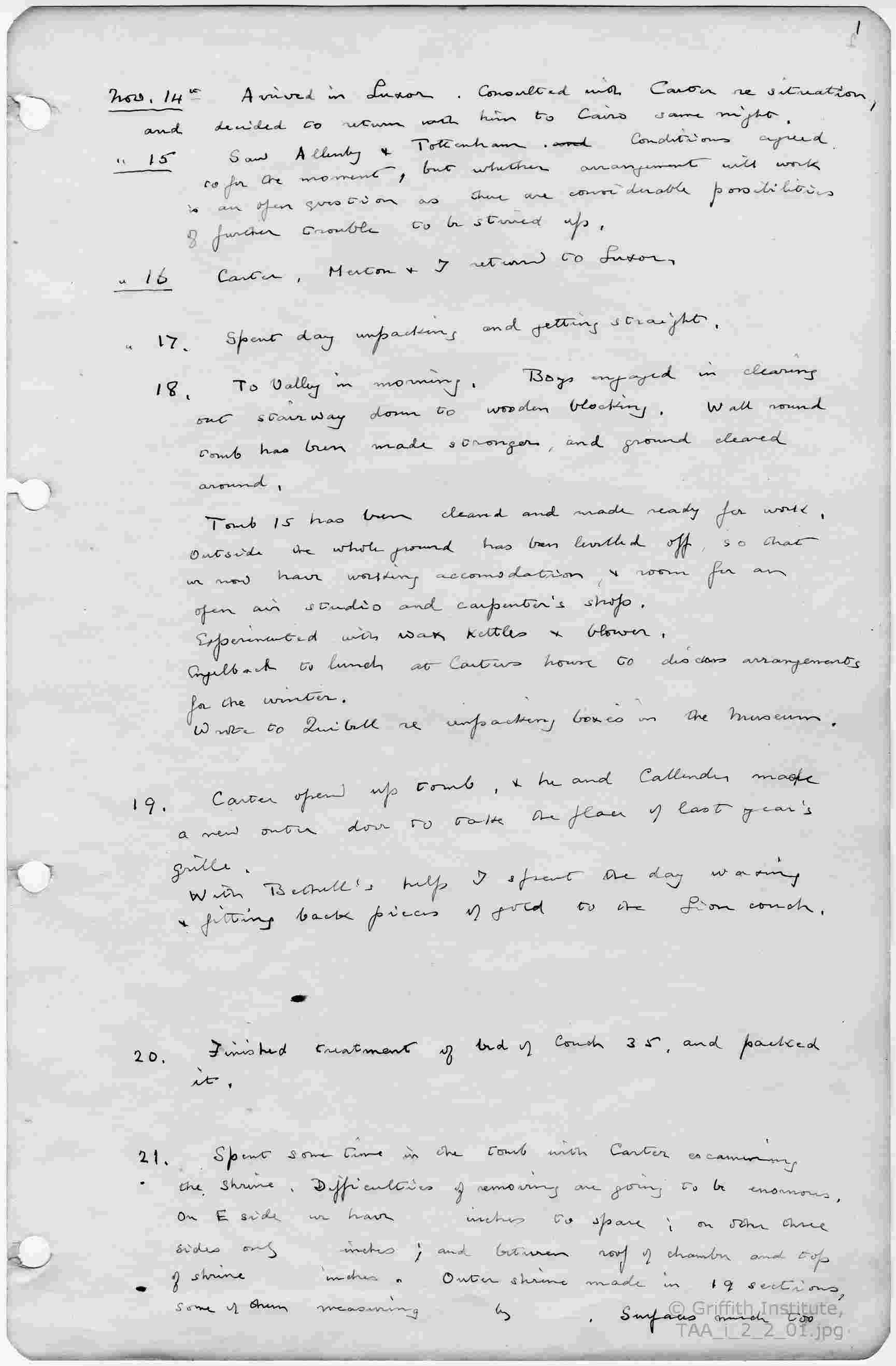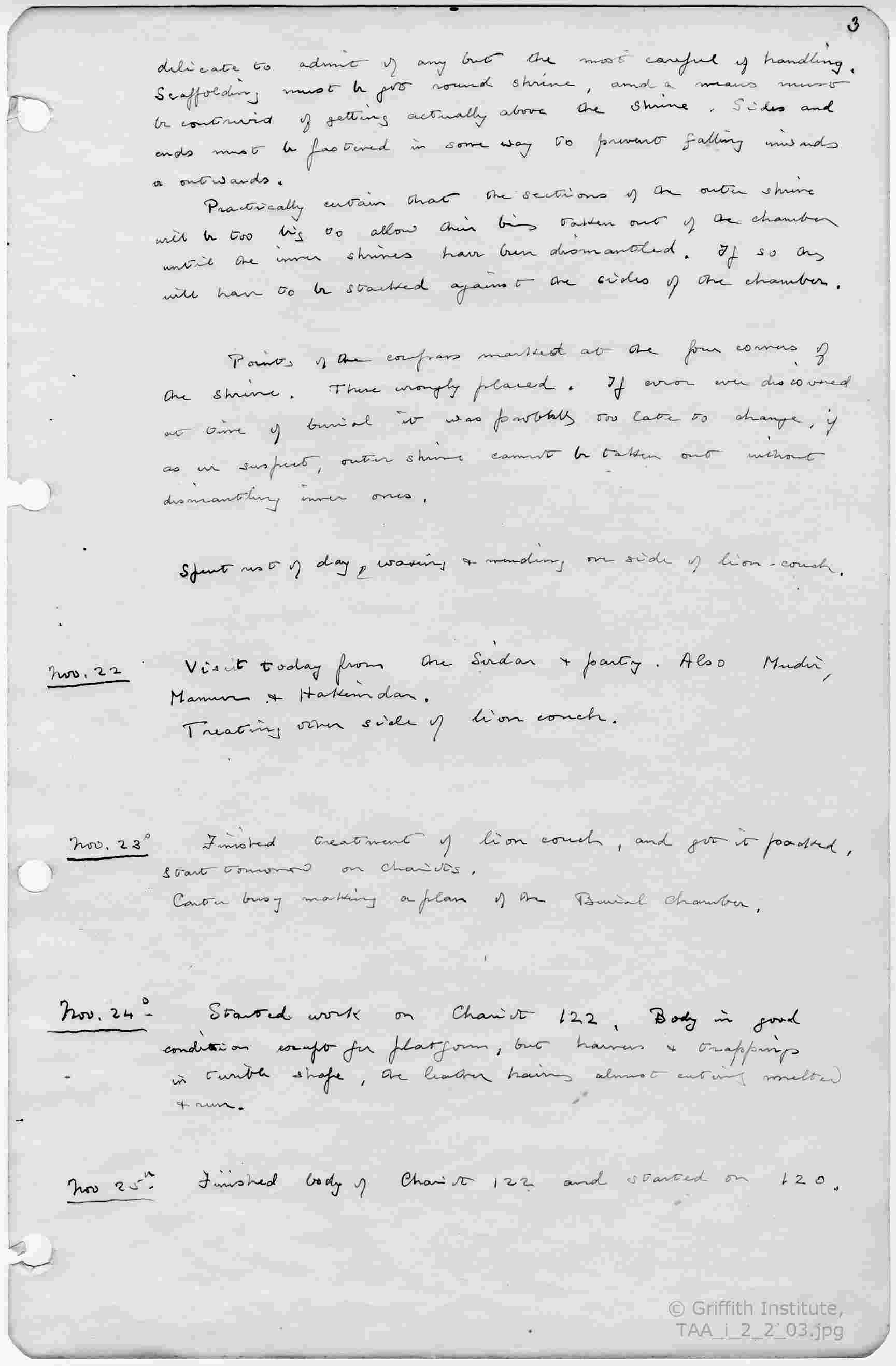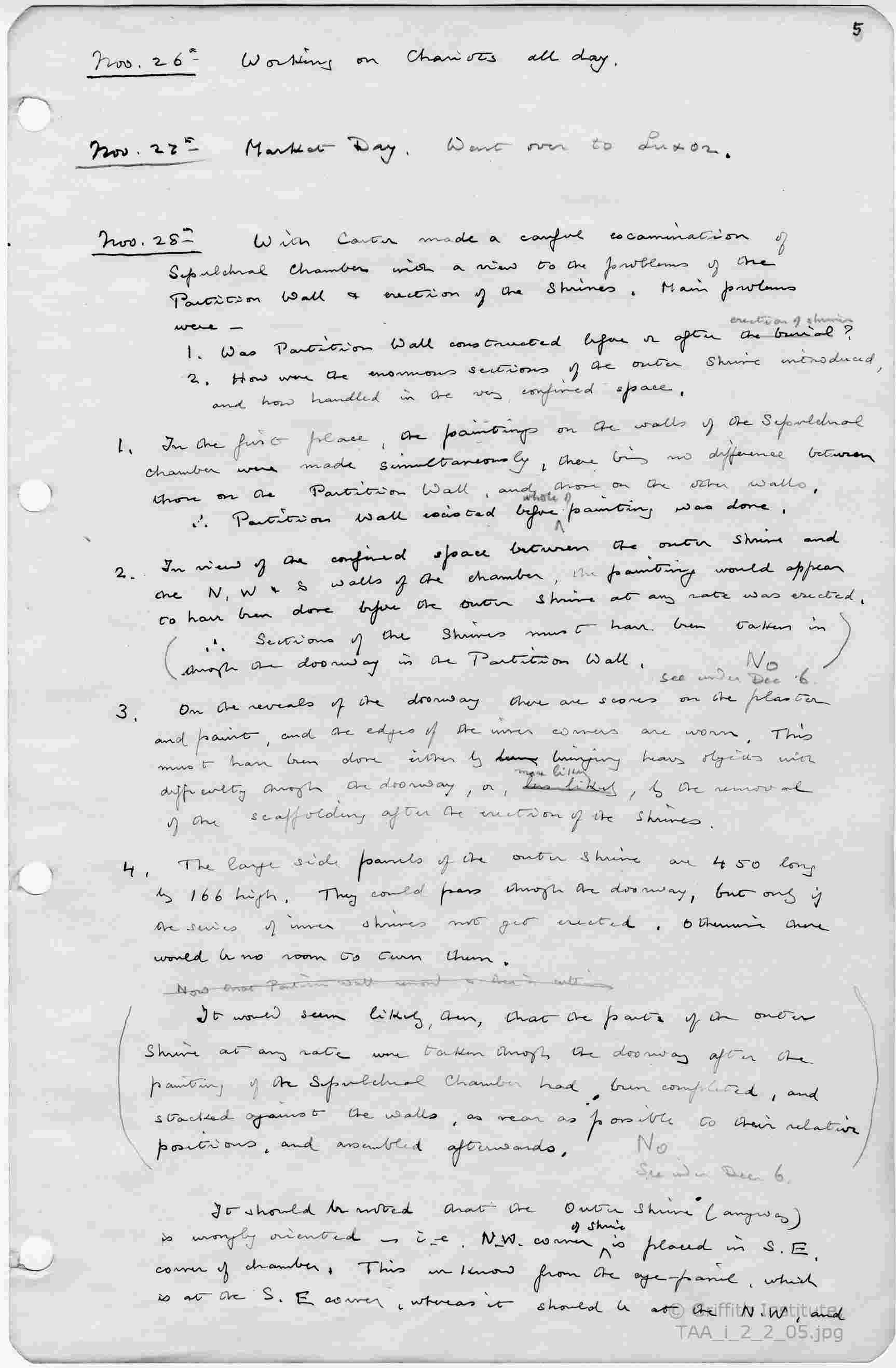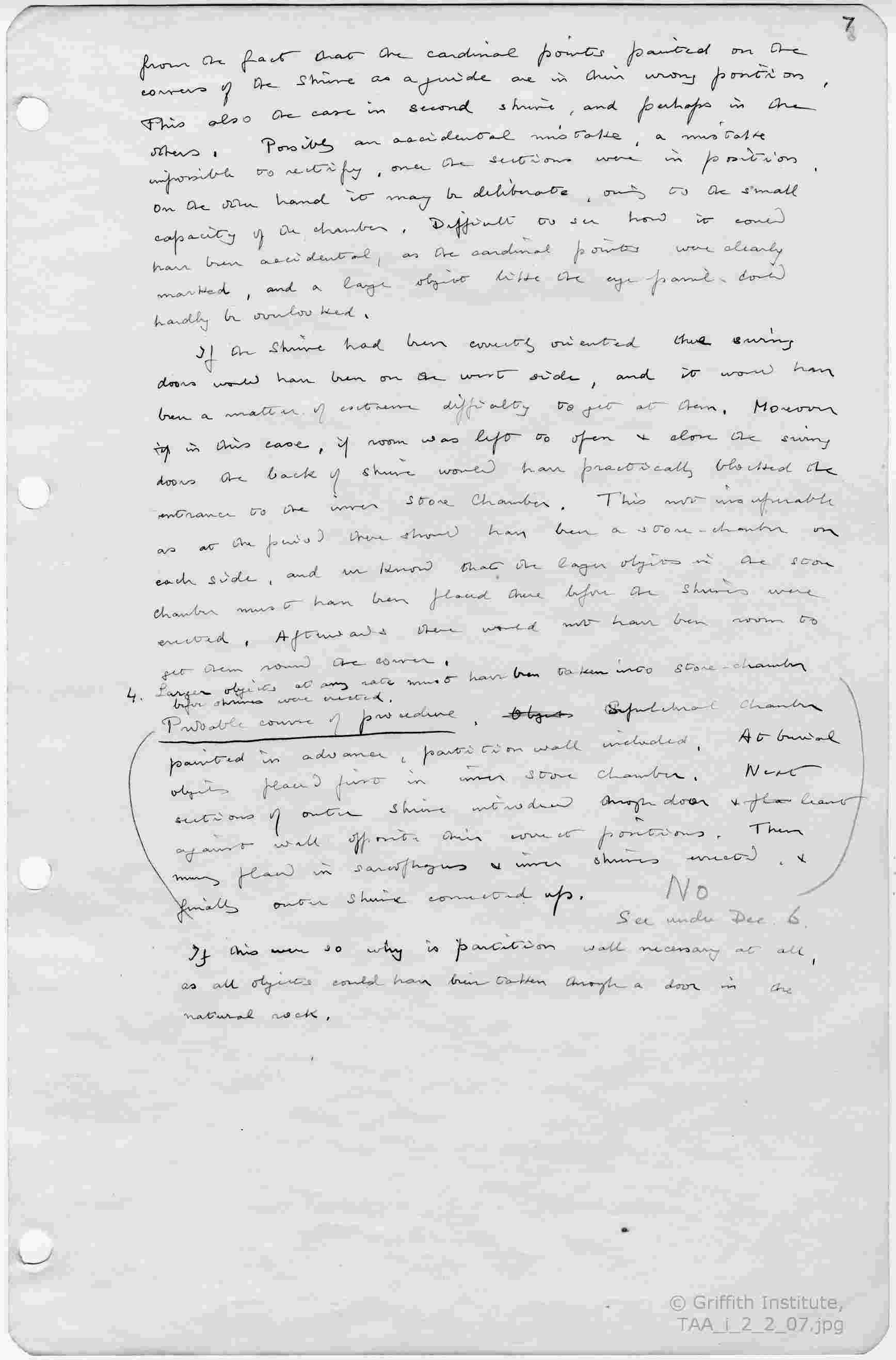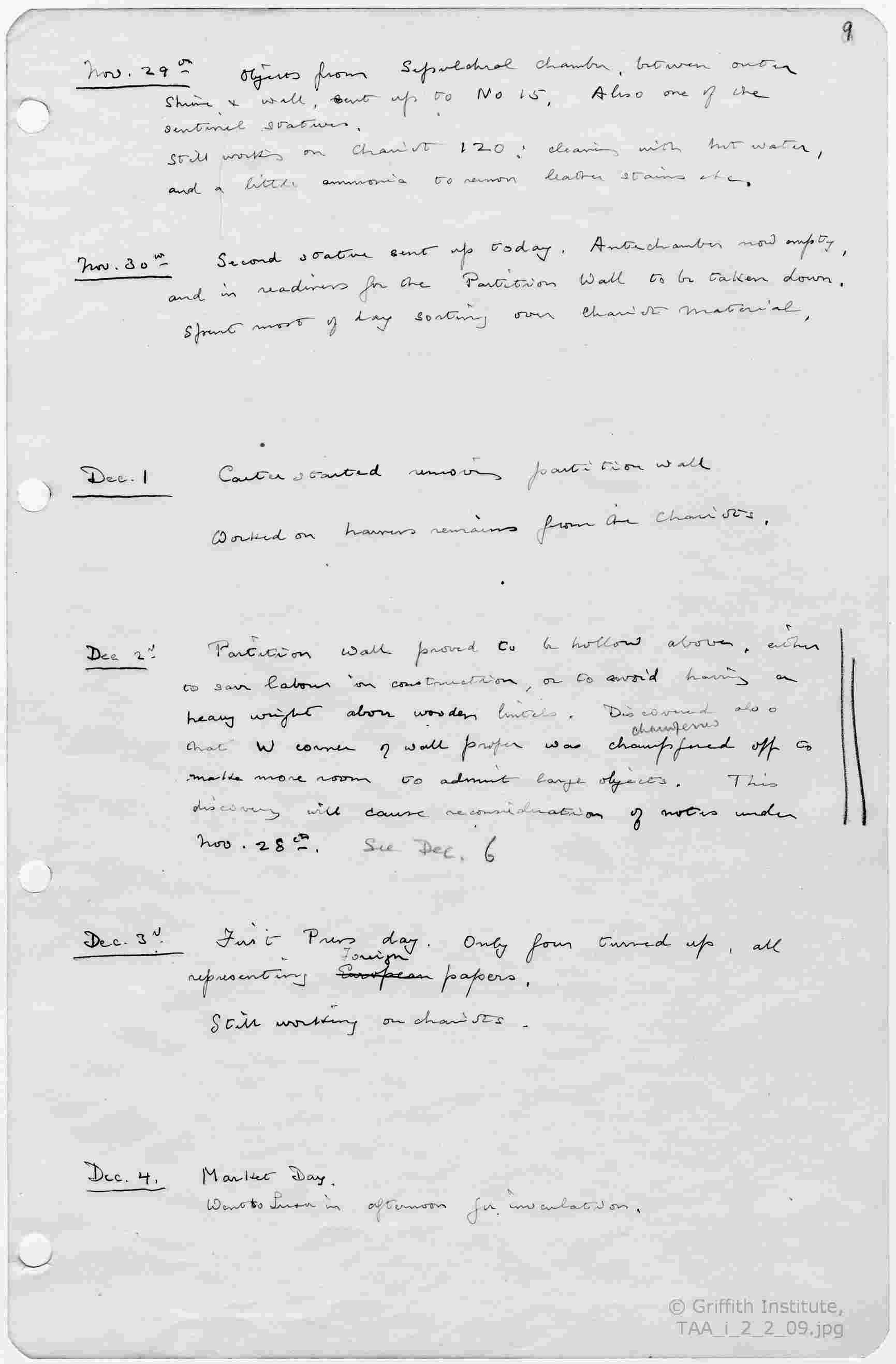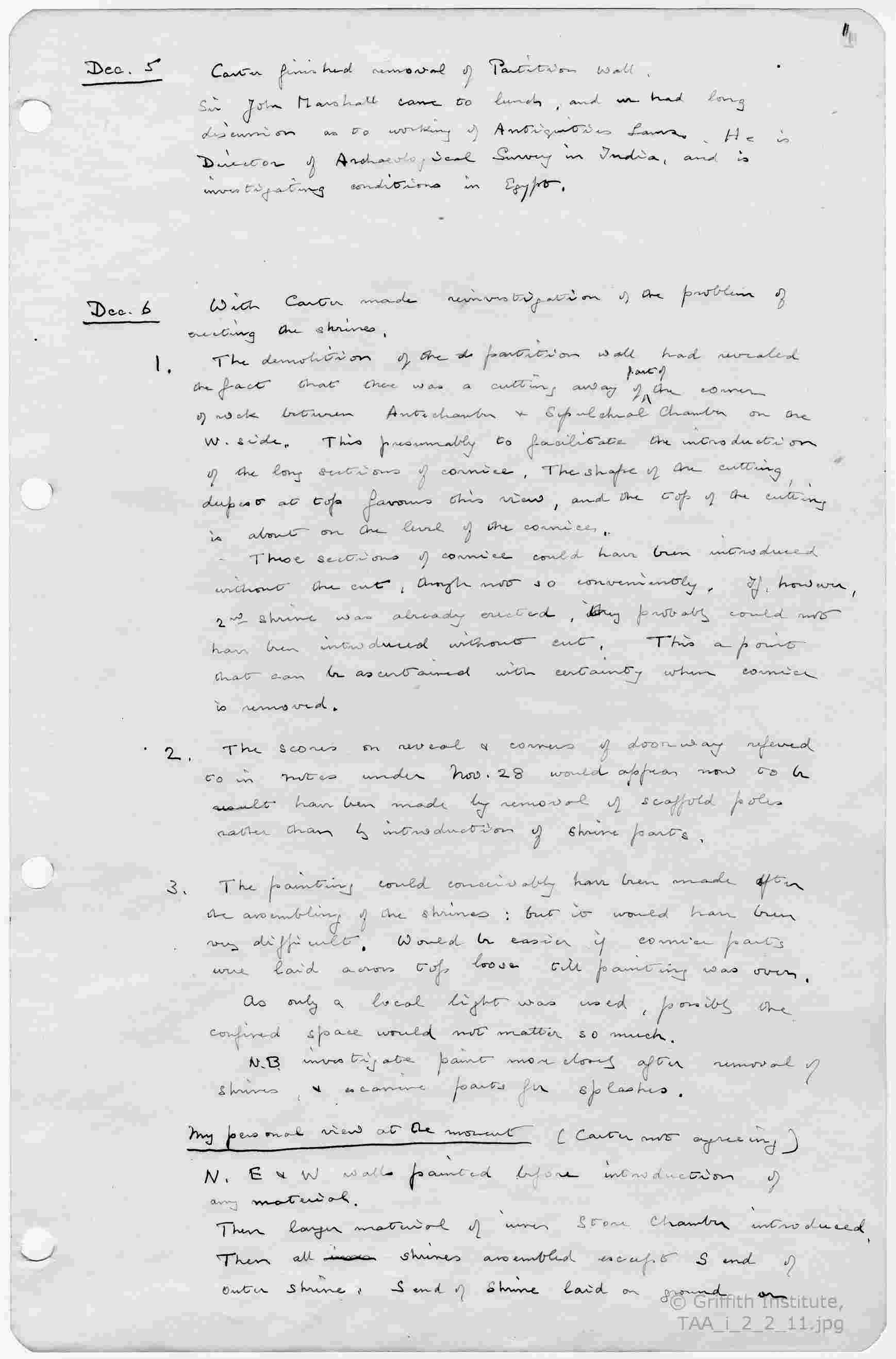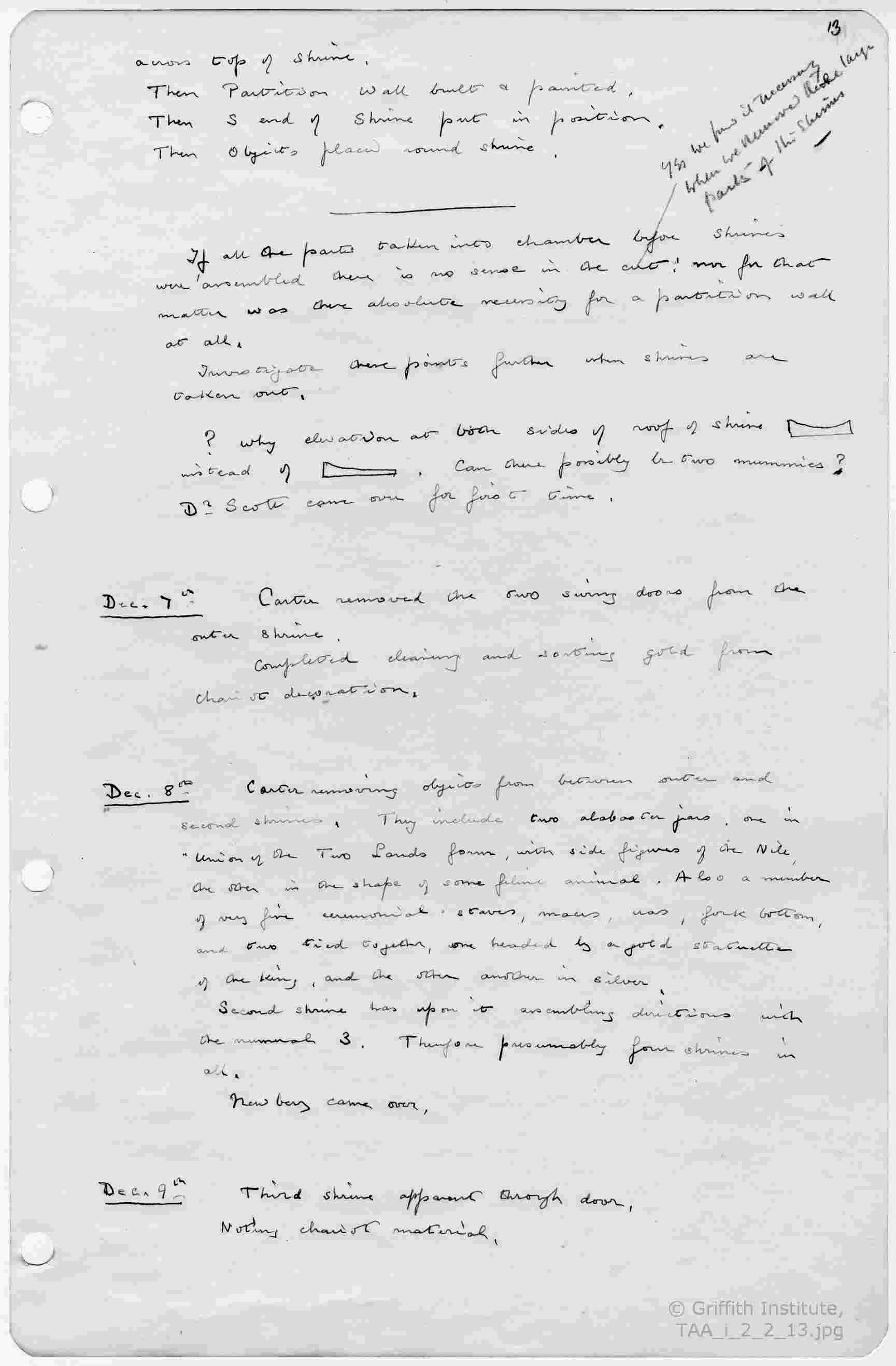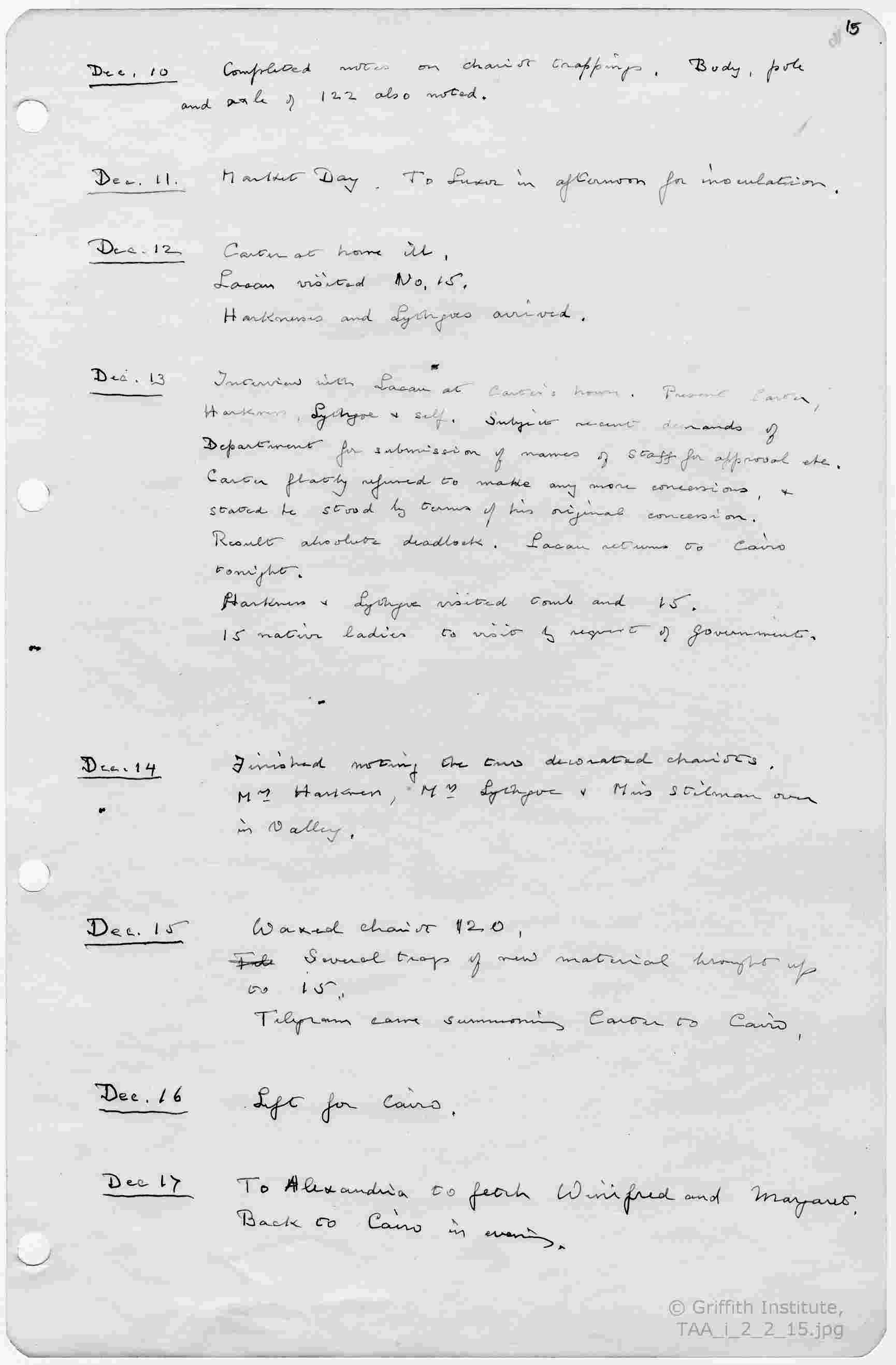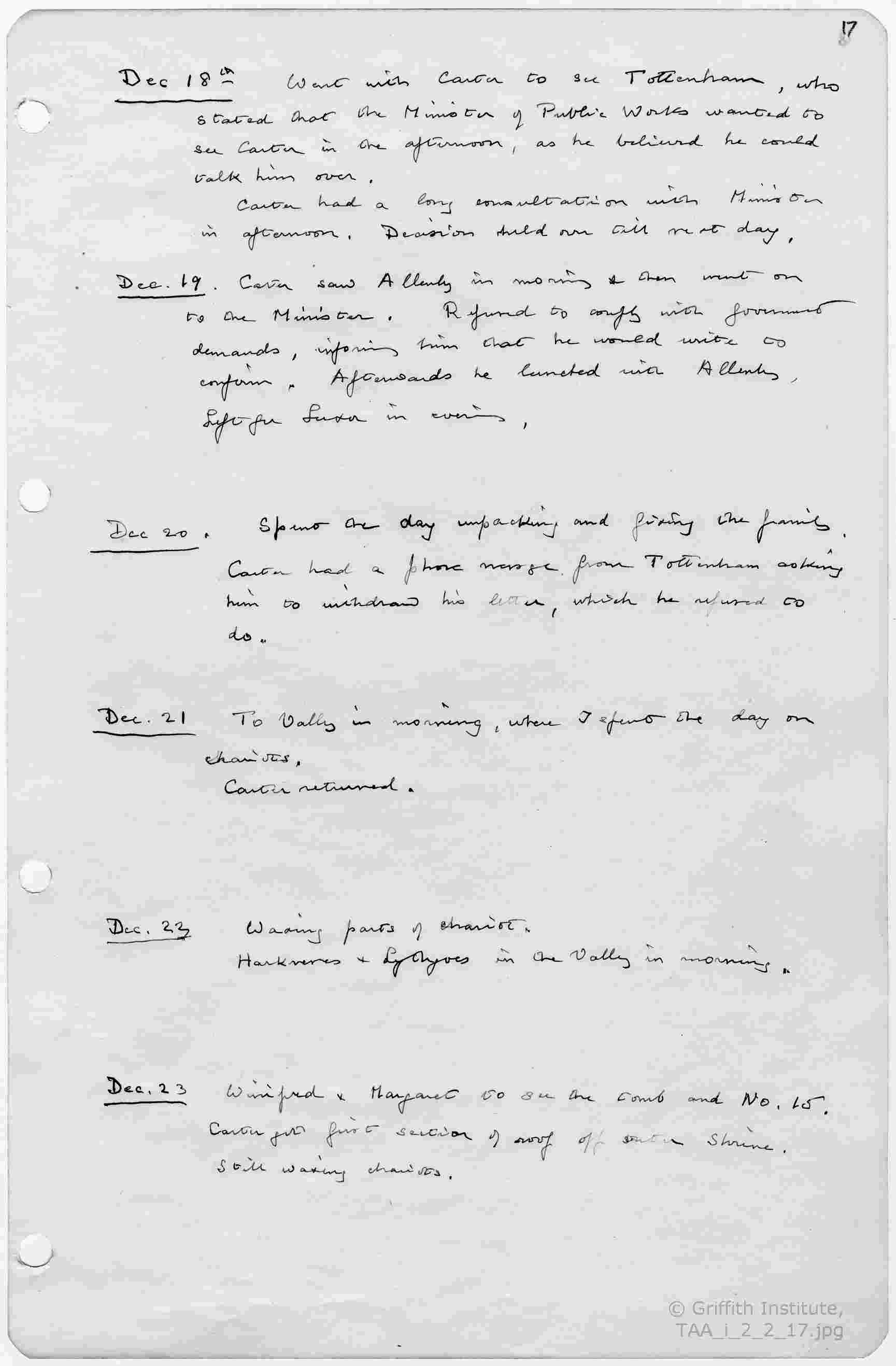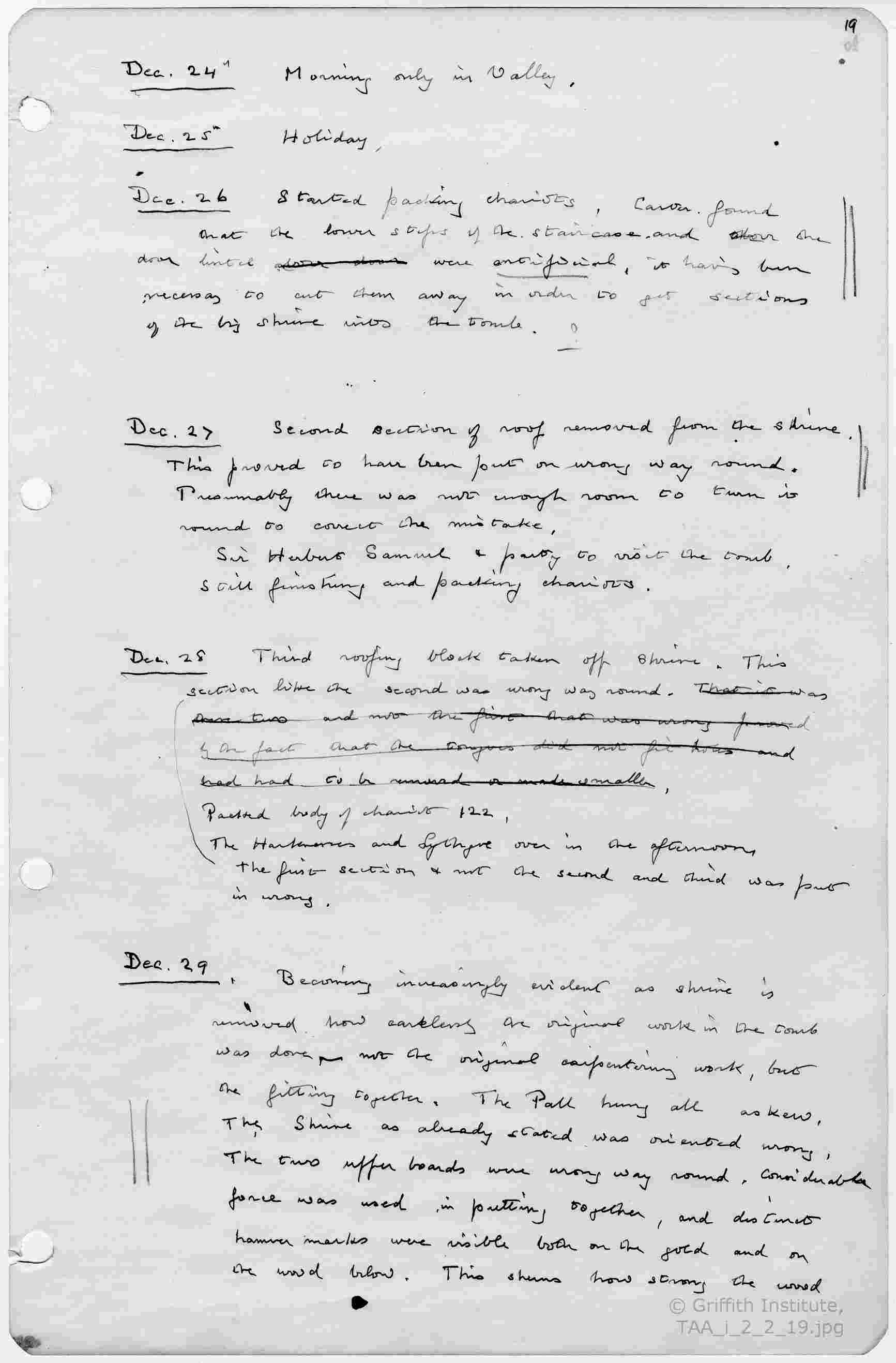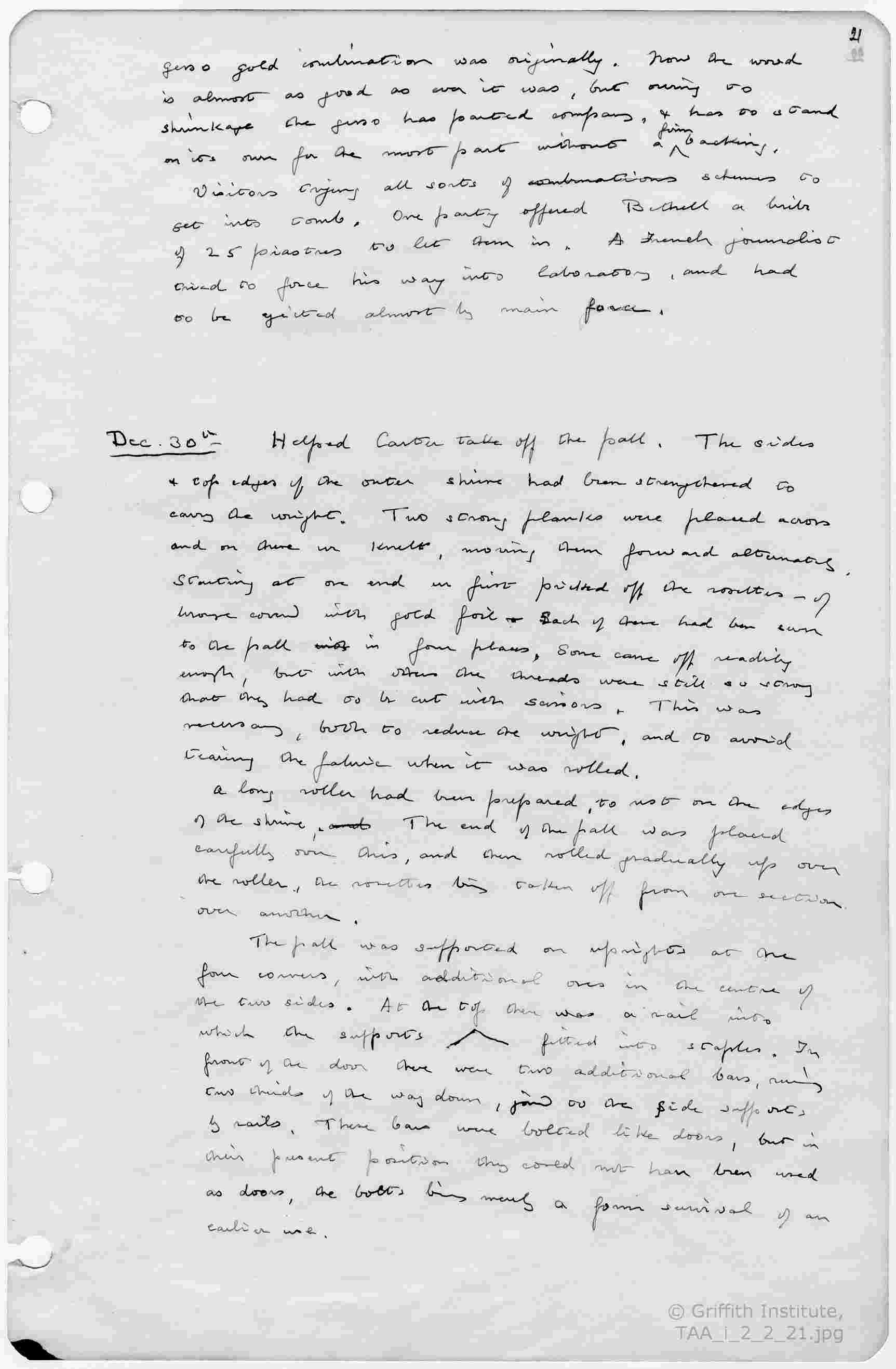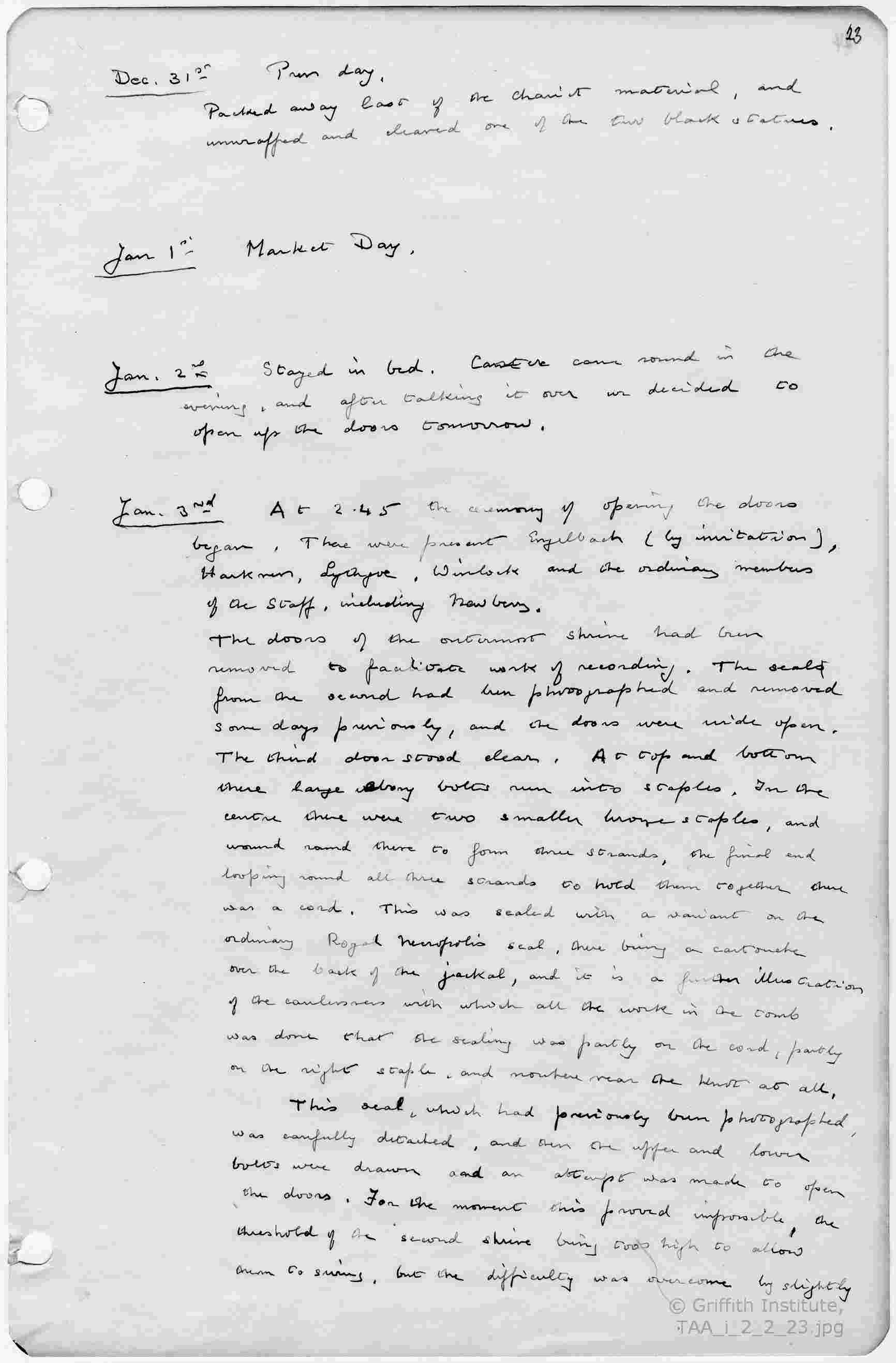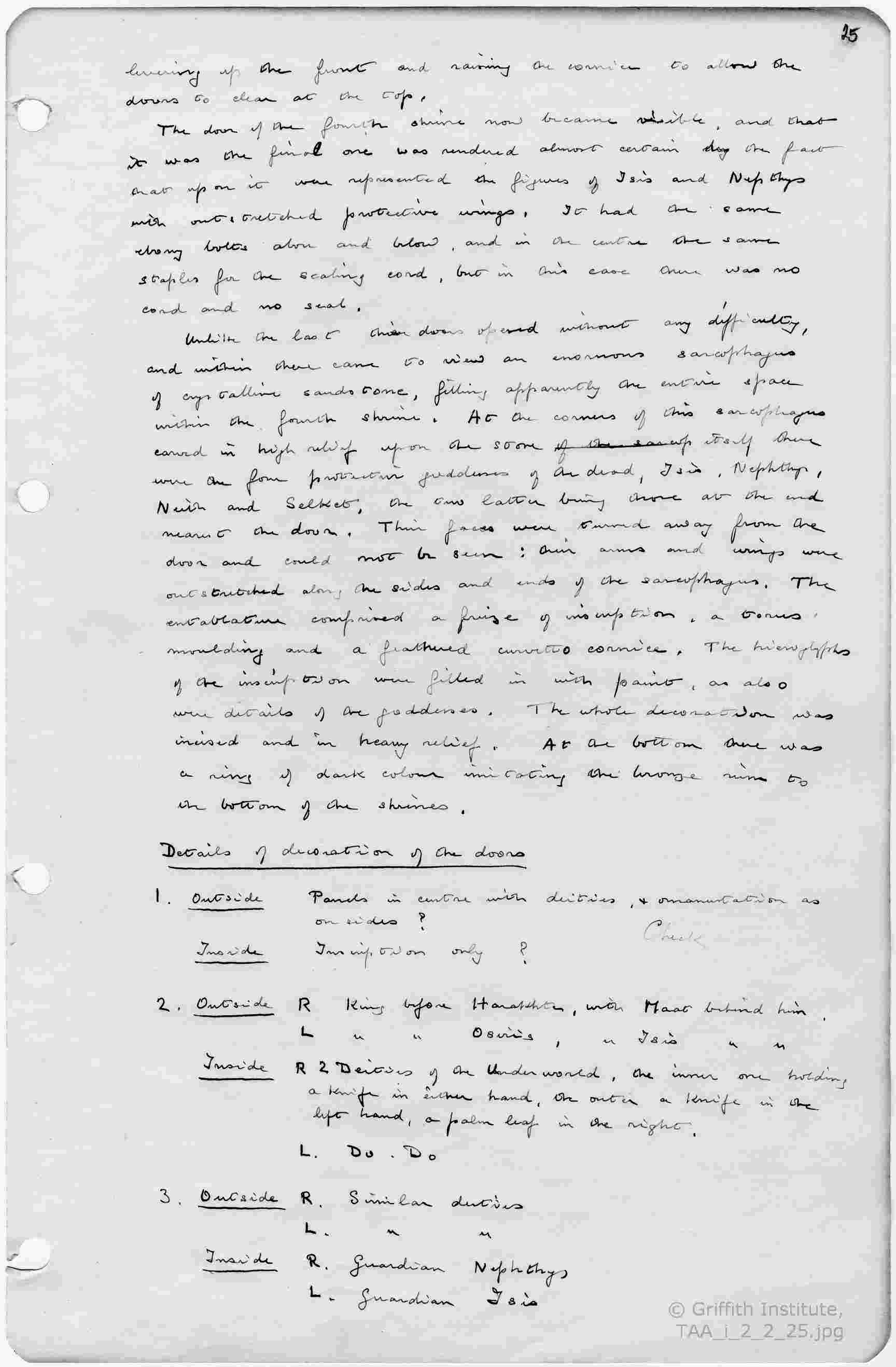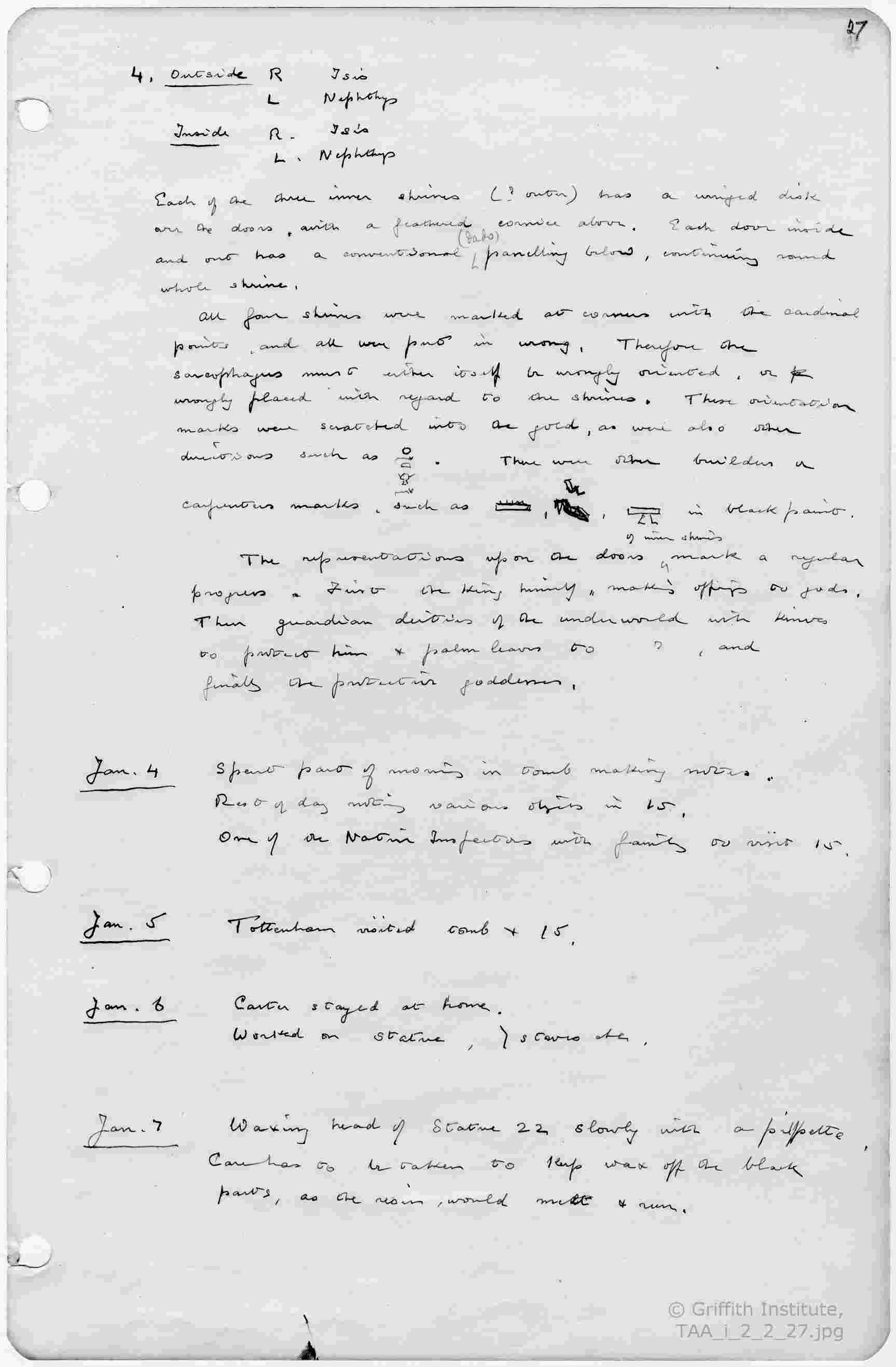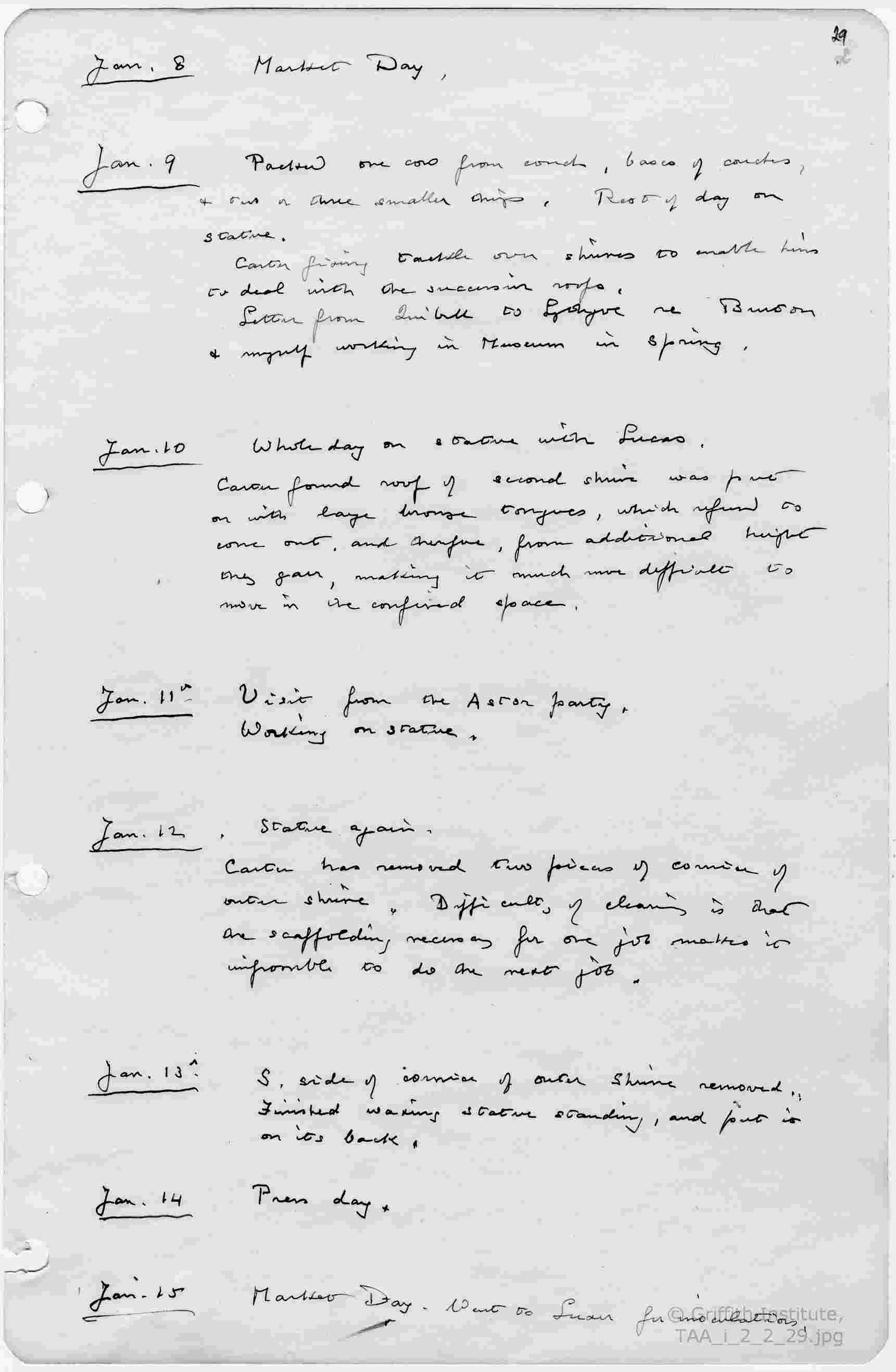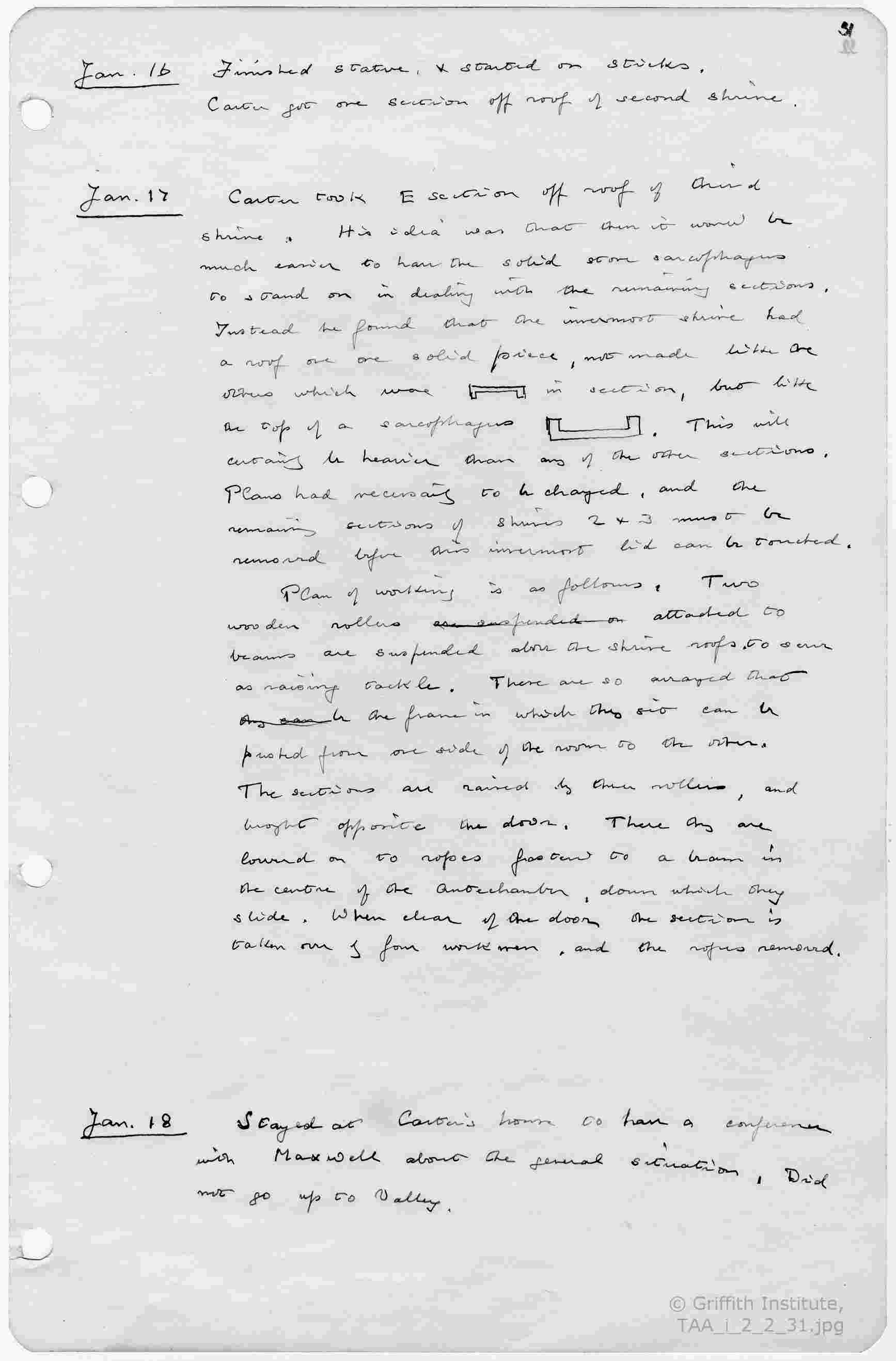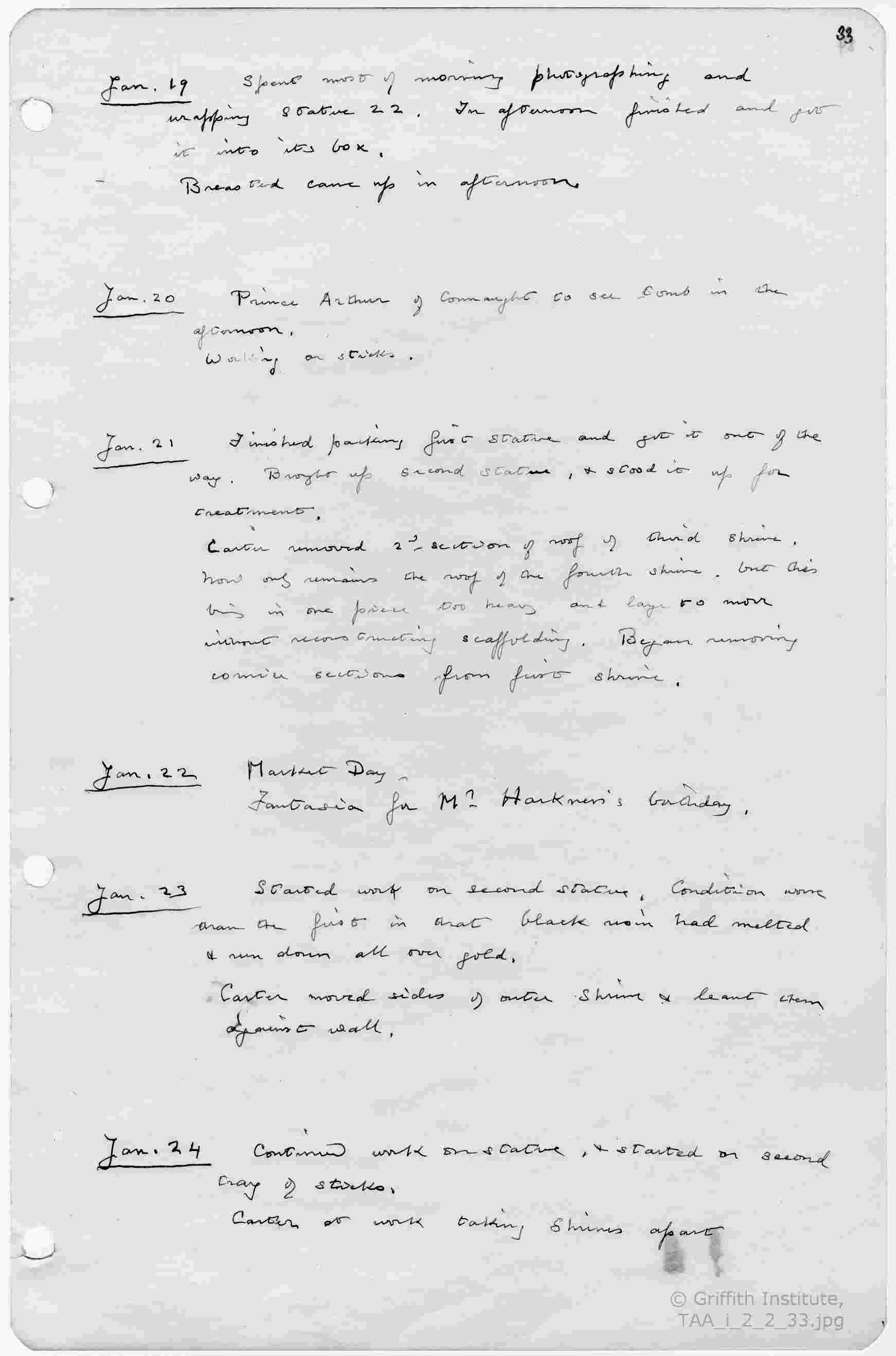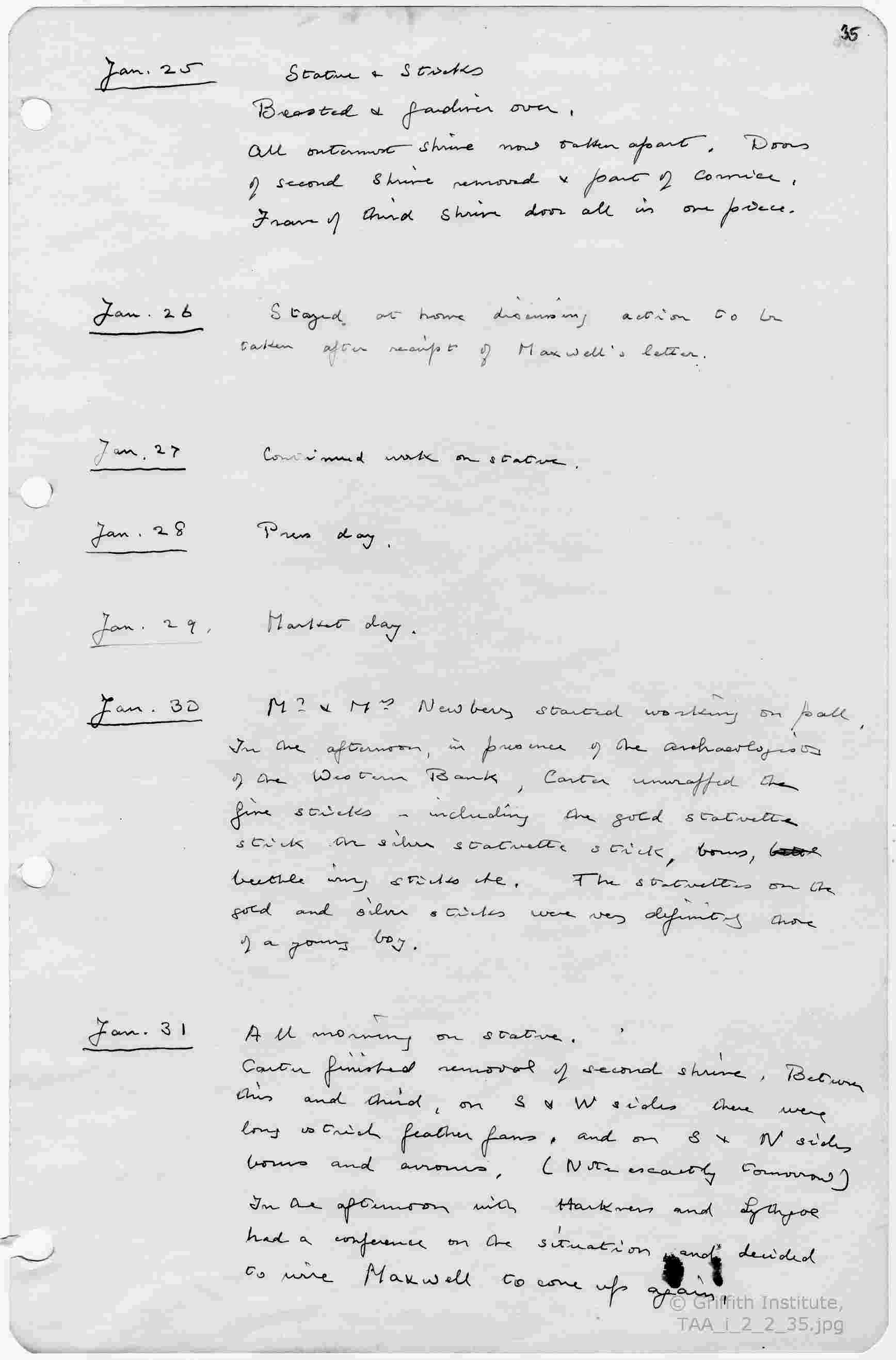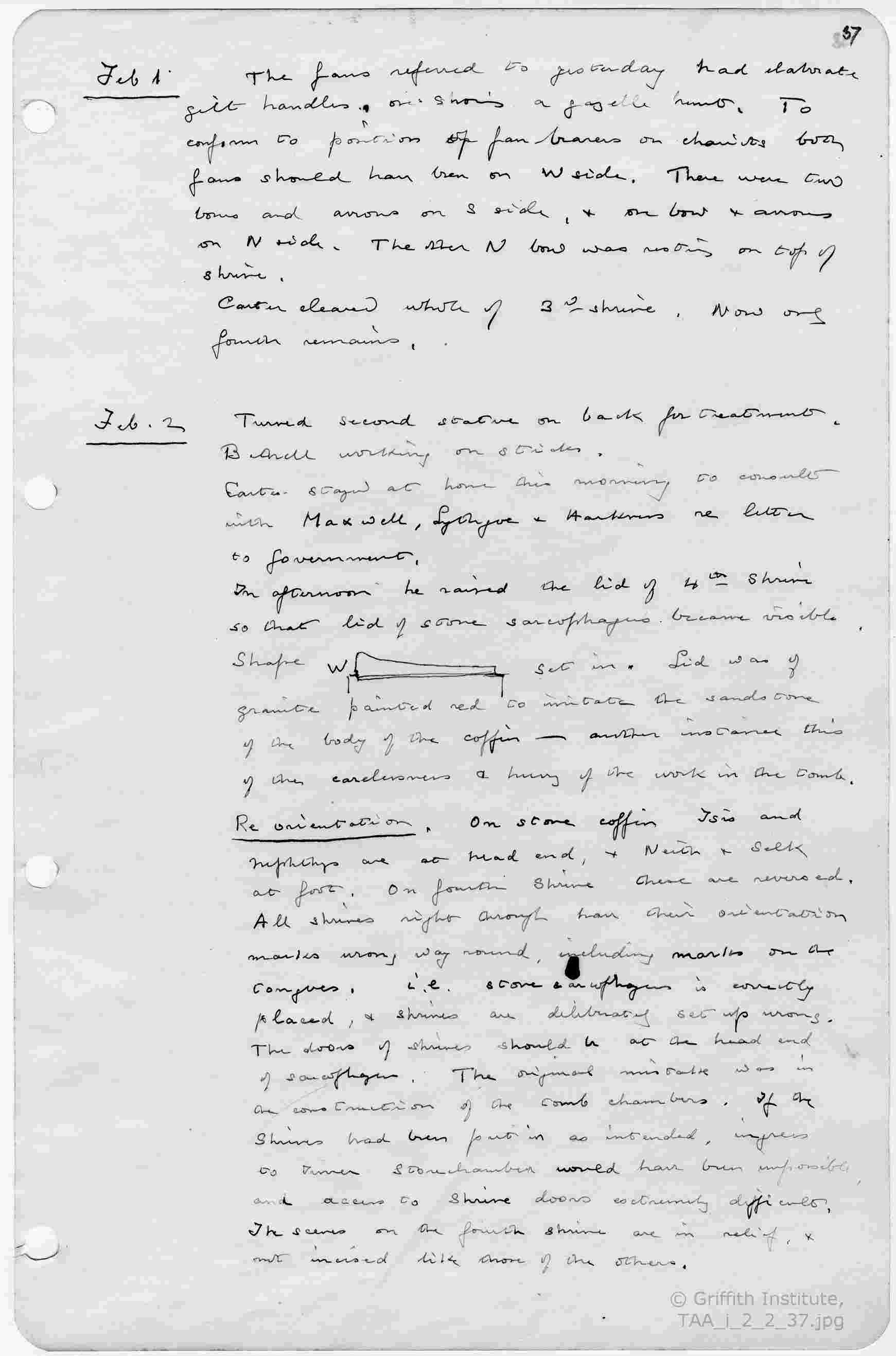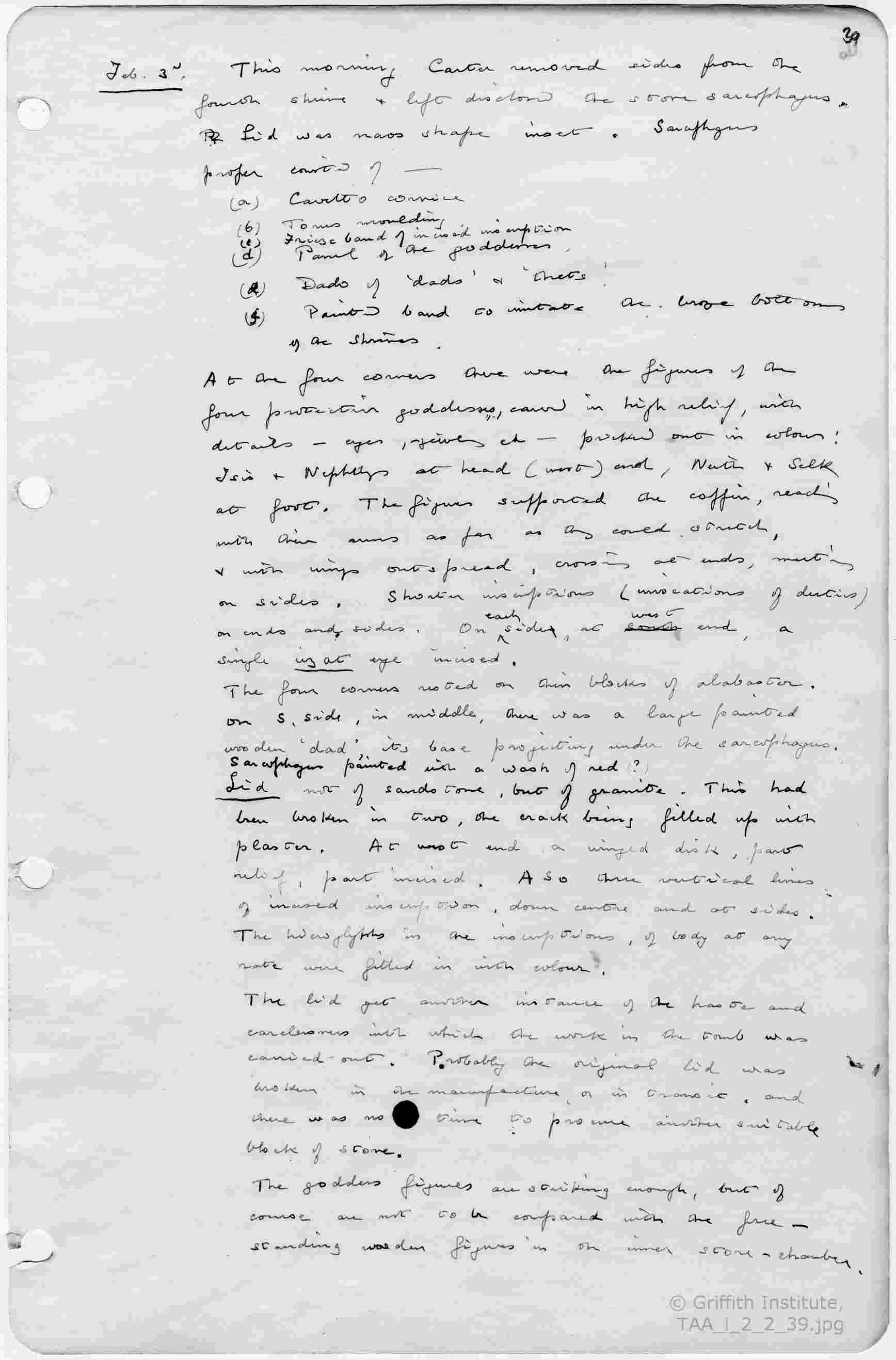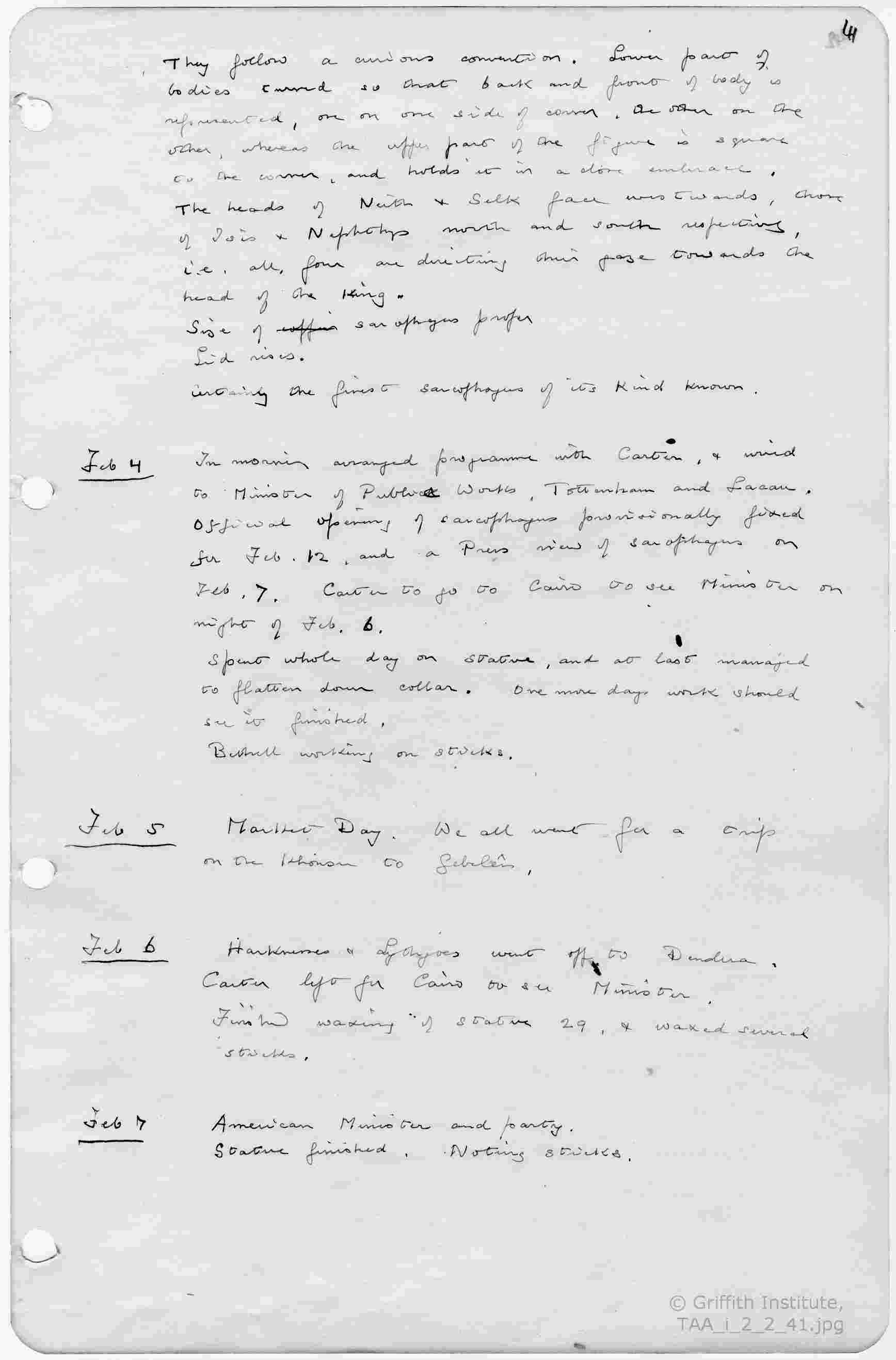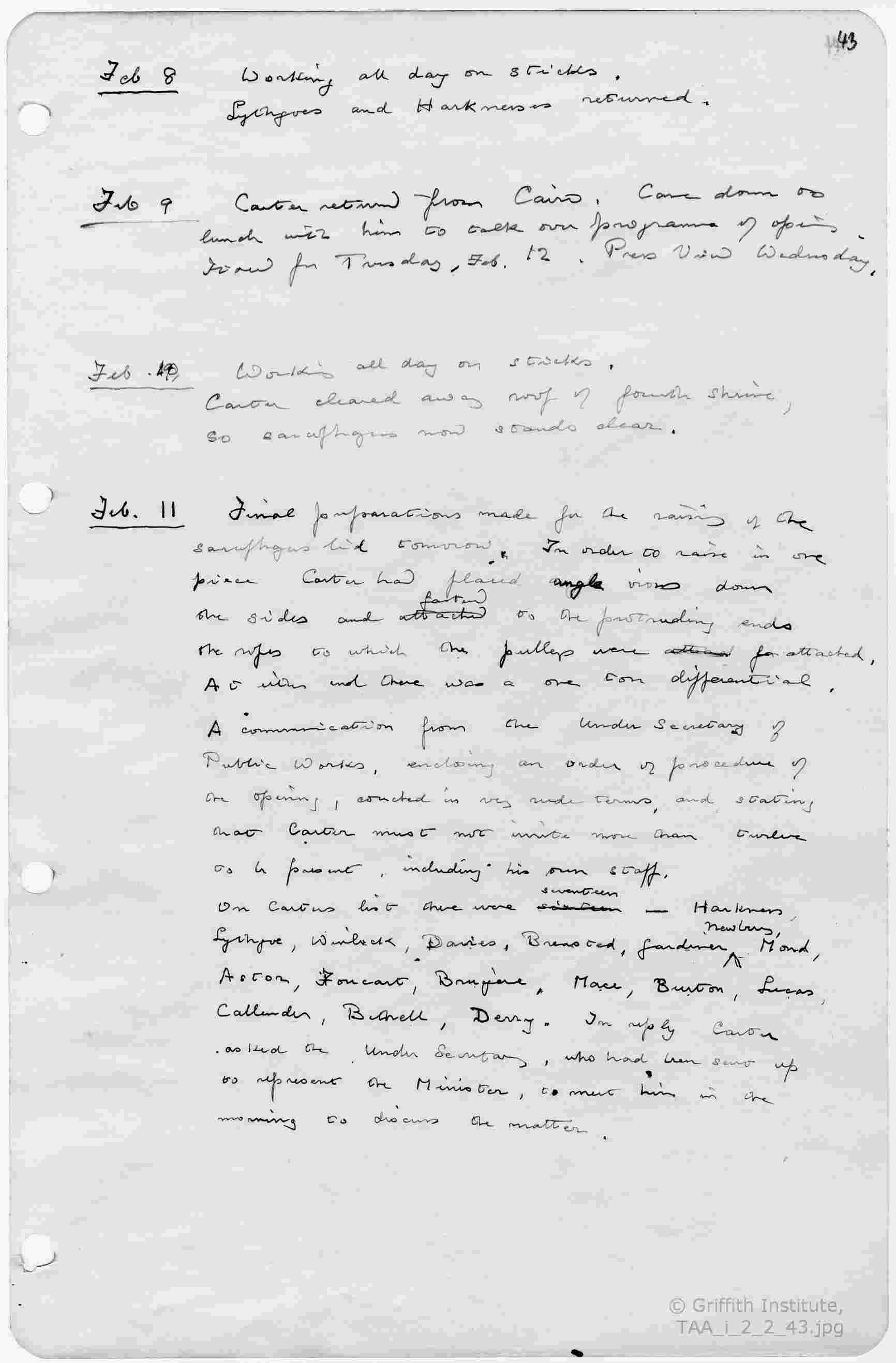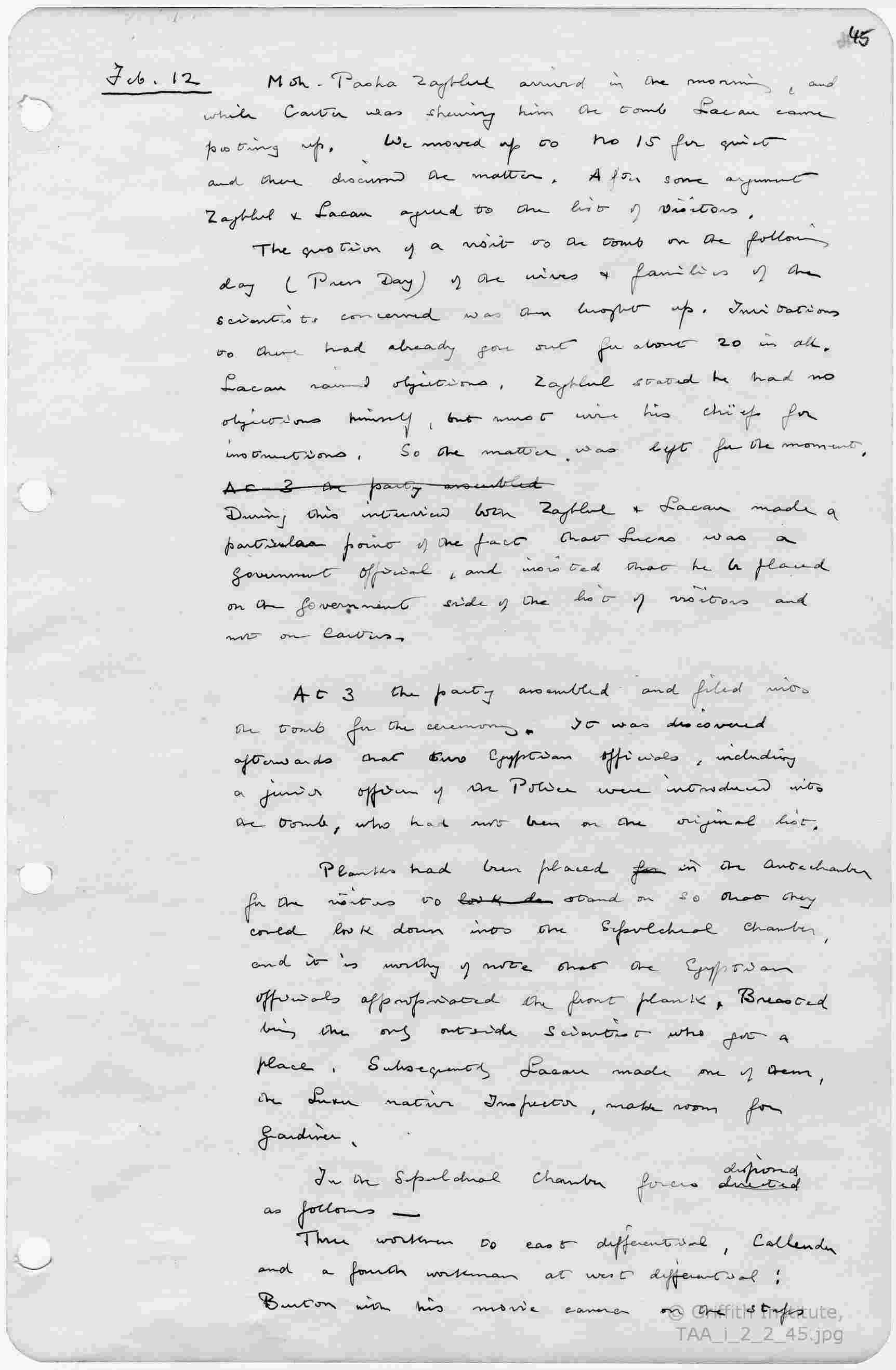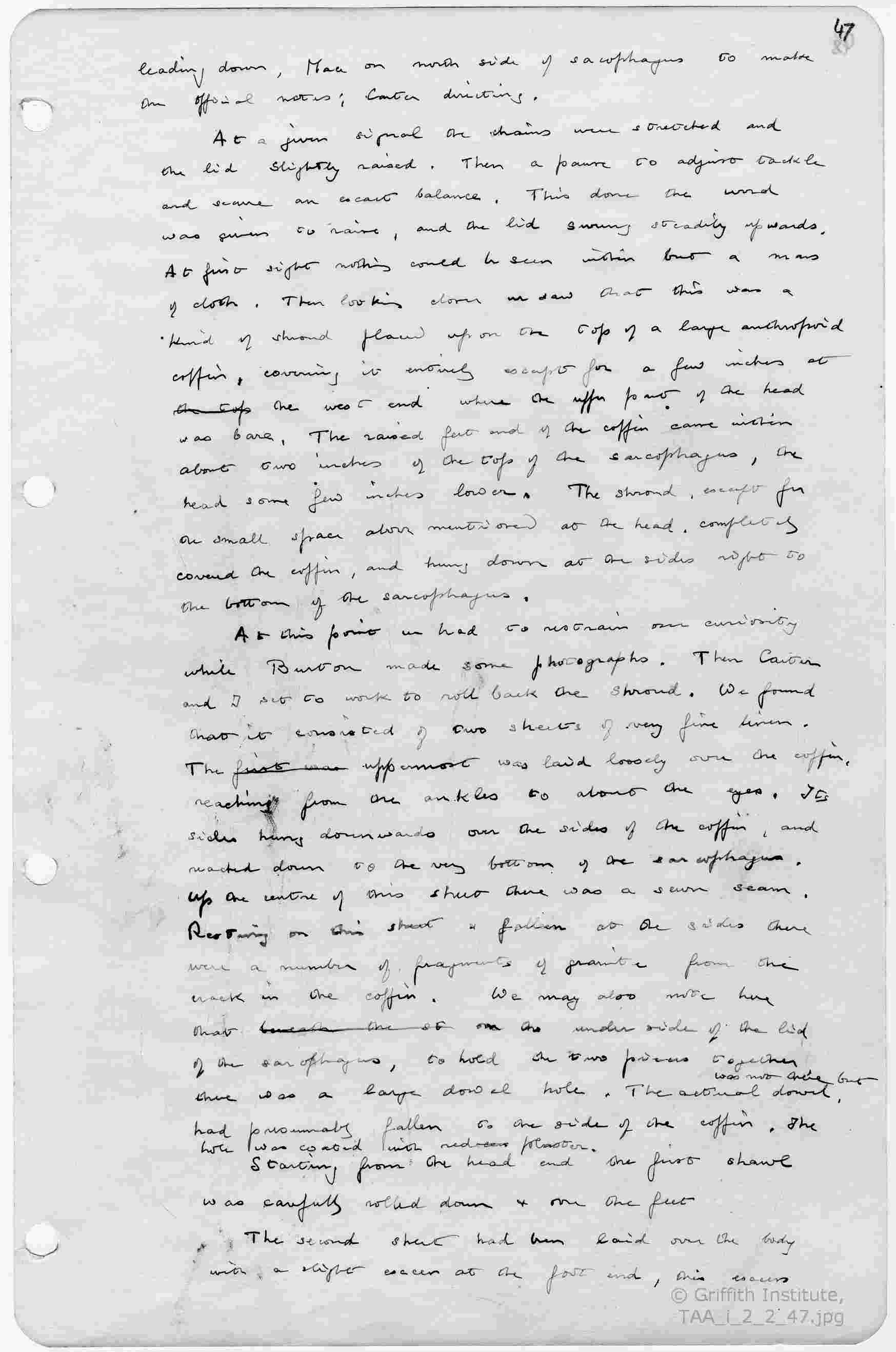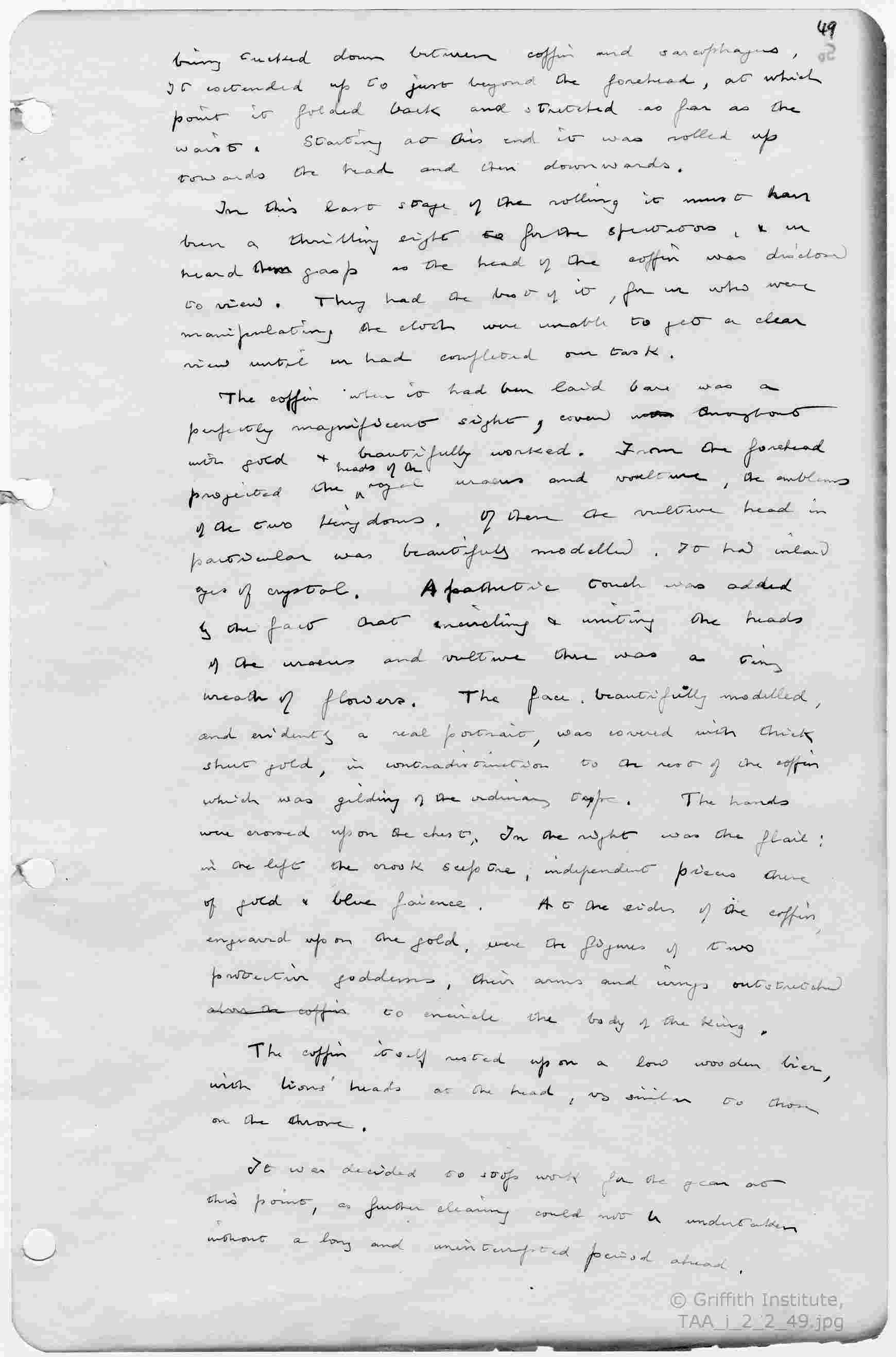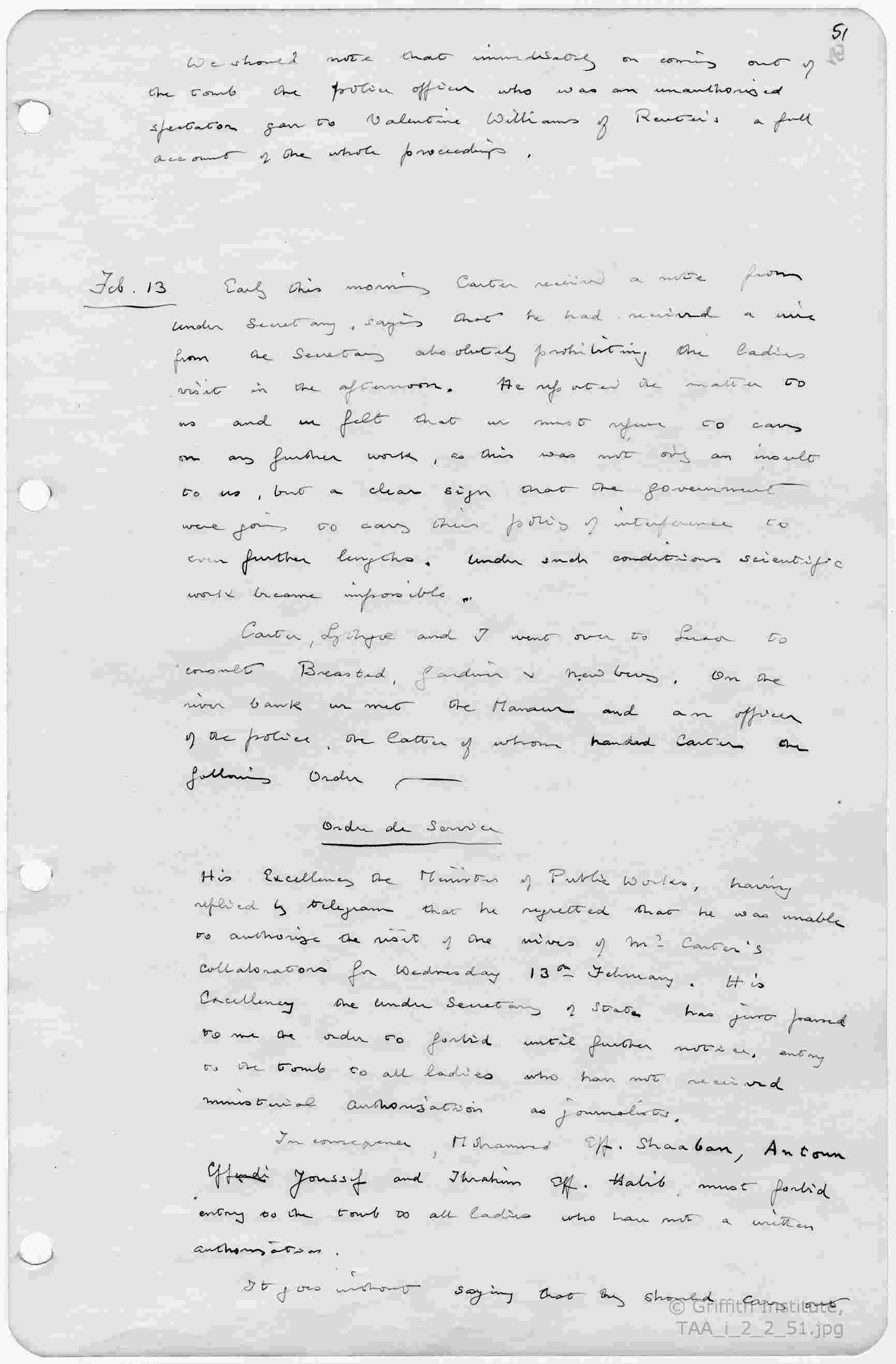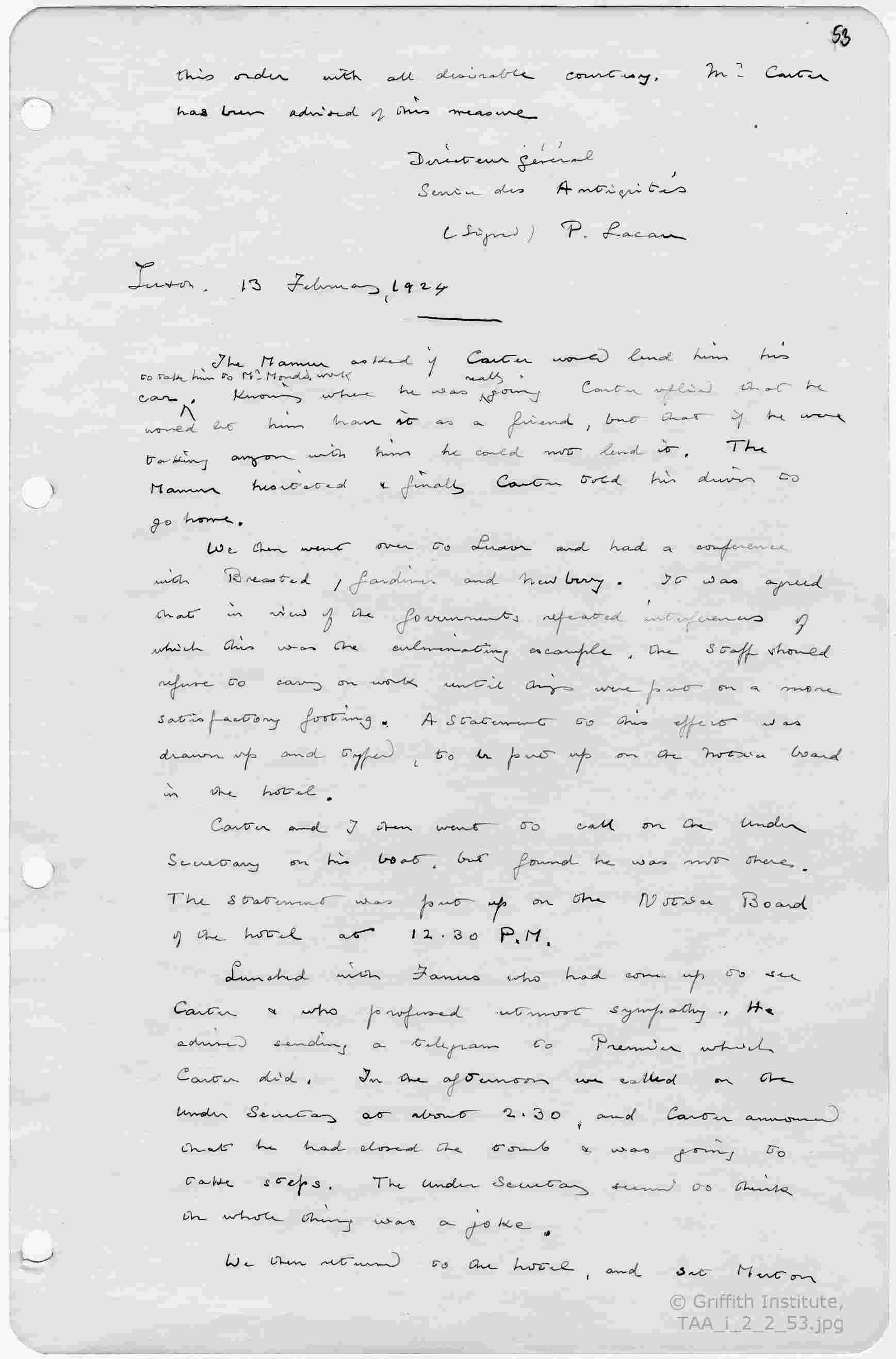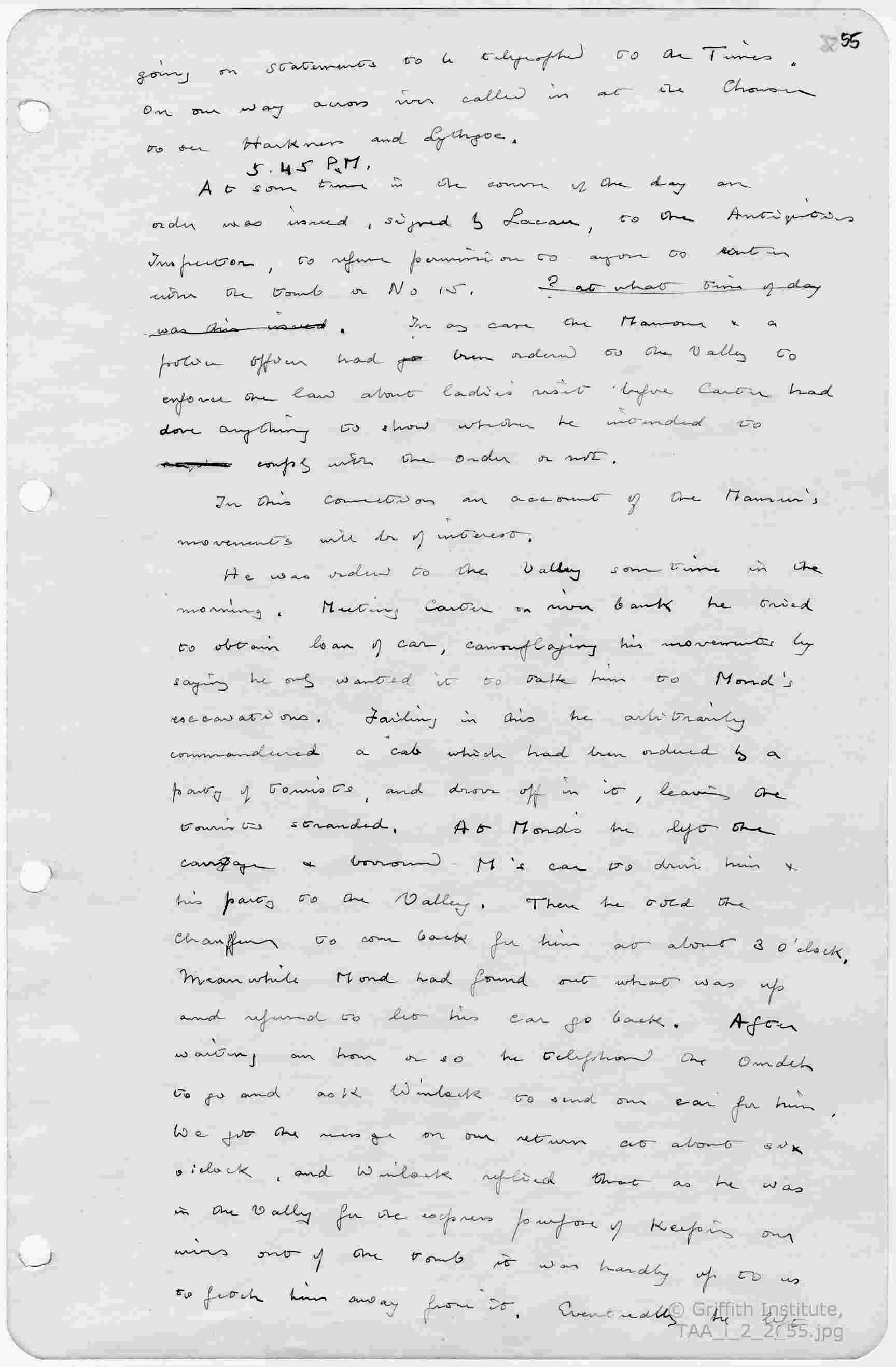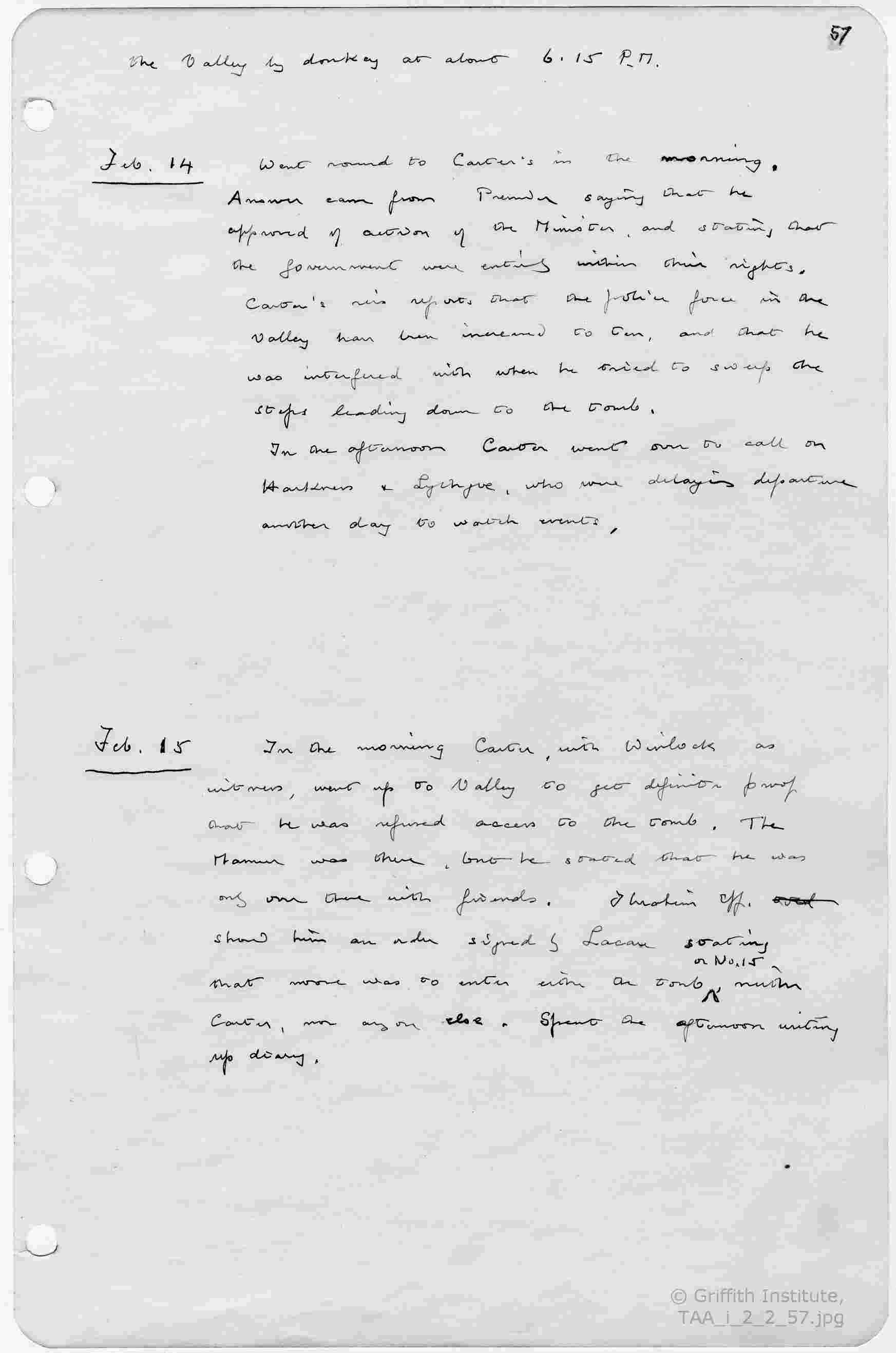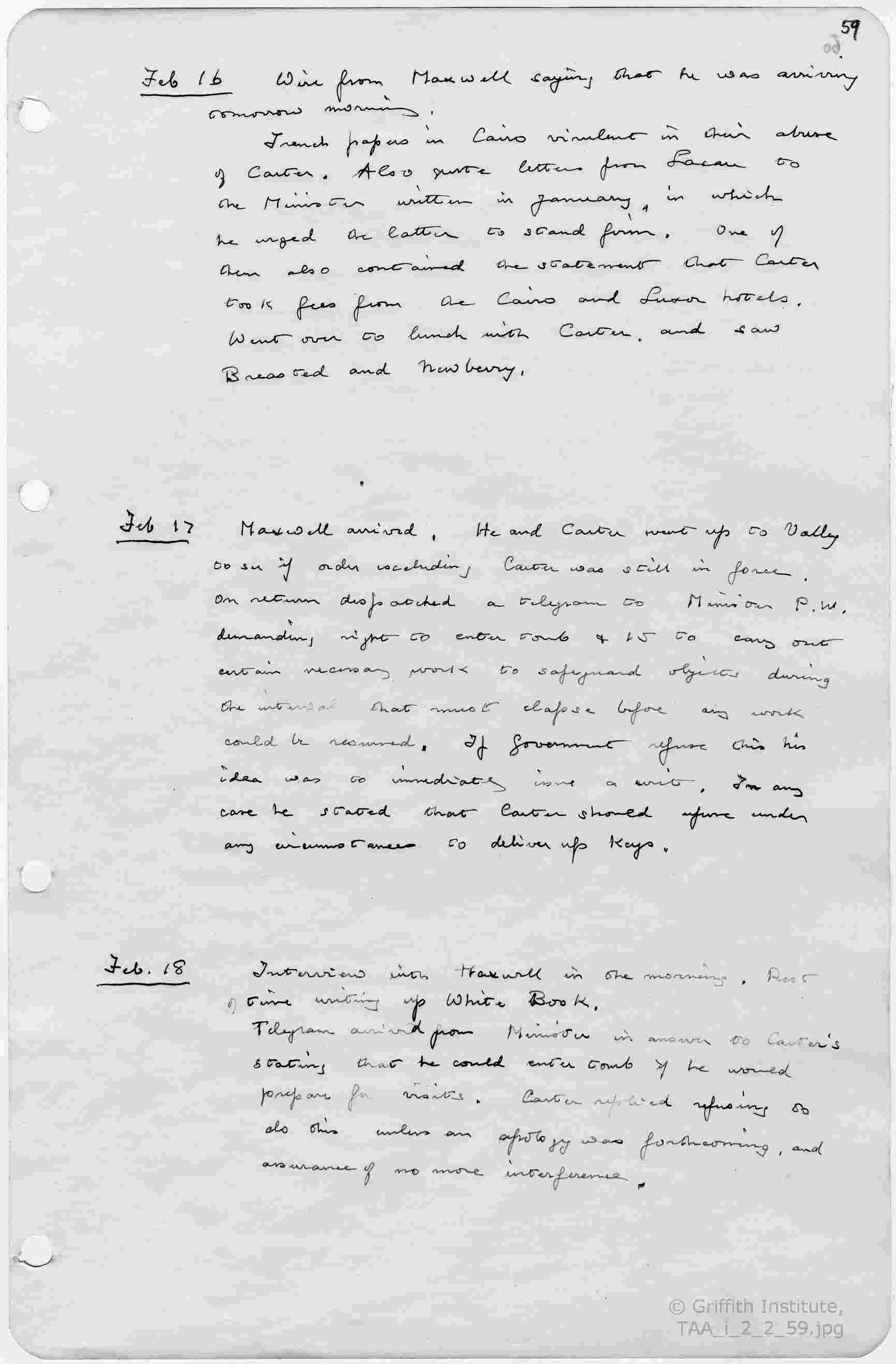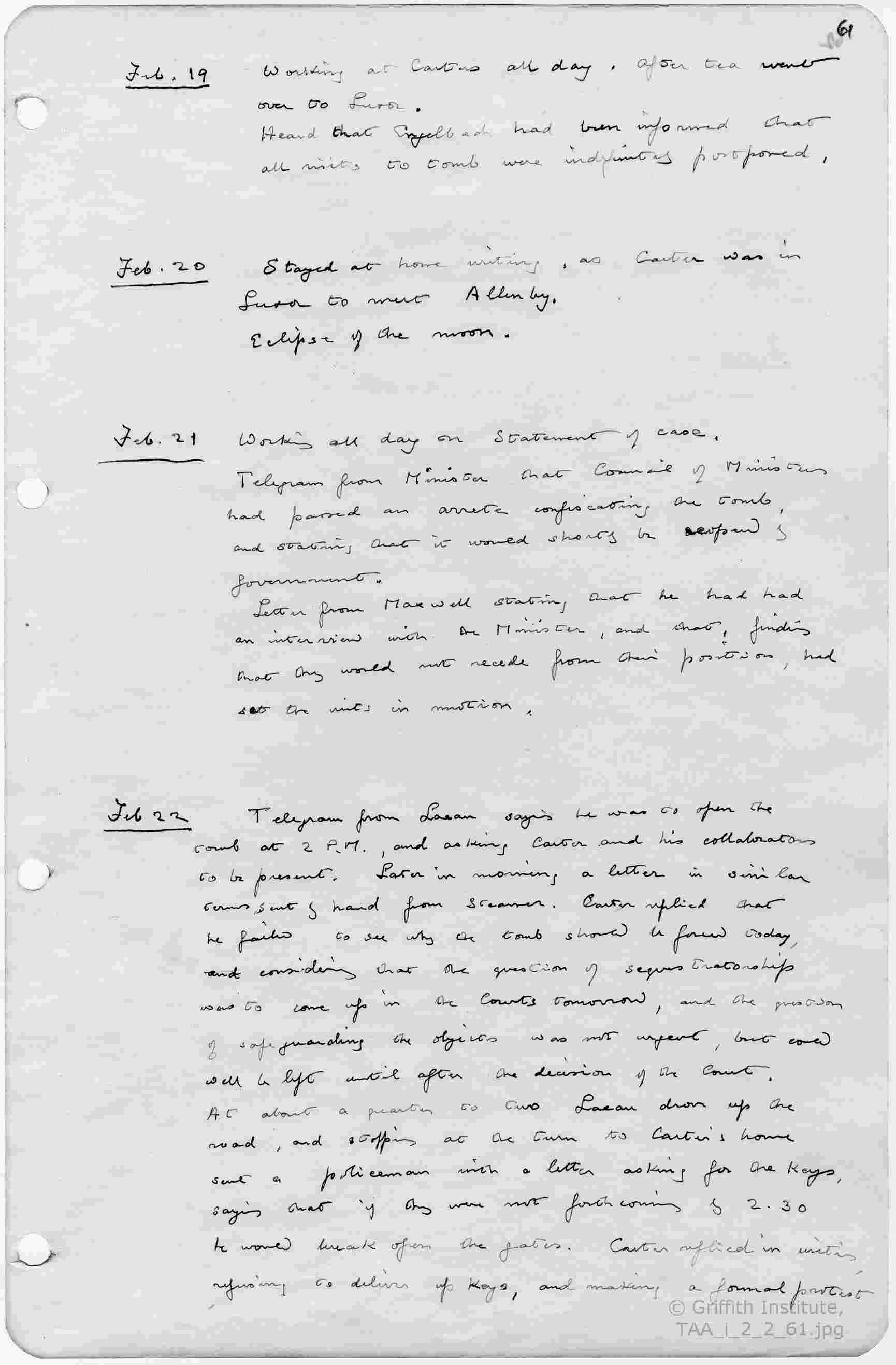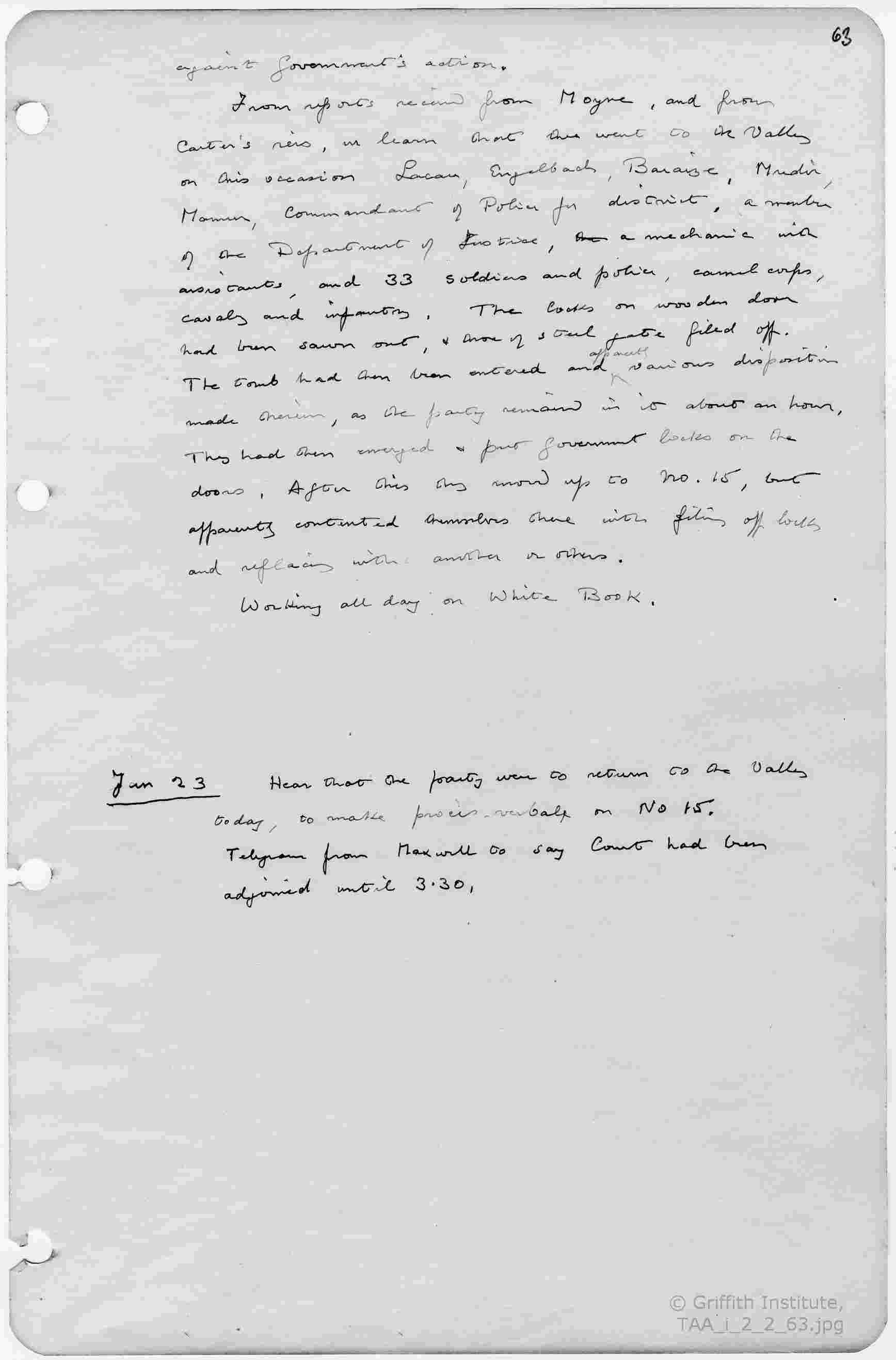Excavation journals made by Howard Carter and Arthur Mace
Arthur C. Mace's excavation journals (transcripts and scans)
2nd Season, November 14th 1923 to February 23rd 1924
This is Arthur Mace's journal for the 2nd excavation season of the tomb of Tutankhamun which took place during the Winter of 1923-4. The events covered by this journal are the assessment of the sepulchral shrines in the Burial Chamber (November 28th 1923), removal of the pall (December 30th 1923), the moment when all the doors of the sepulchral shrines were opened allowing Carter and his team to view the quartzite sarcophagus of Tutankhamun for the first time (3rd January 1924), the raising of the sarcophagus-lid revealing the coffins (February 12th 1924) and a dispute with the Service des Antiquités which brought a premature end to the season (February 13th 1924 onwards).
The journal is housed within its original black ring-binder, it is stamped "Walker's Loose-Leaf Book, Cover Number 138" on the inside front cover, measures 34 by 24 by 1 cm. and contains 32 loose-leaf unlined pages. TAA Archive i.2.2, pages 1 to 63. All entries are in Arthur Mace's hand.
This transcript follows the format of the original document, and any insertions, deletions or duplications are indicated accordingly. Scans of the original journal pages are provided and are positioned to the right of the transcript, these are magnified by positioning the pointer on the image.
Arrived in Luxor. Consulted with Carter re situation,
and decided to return with him to Cairo same night.
Saw Allenby & Tottenham. and Conditions agreed
to for the moment, but whether arrangement will work
is an open question as there are considerable possibilities
of further trouble to be stirred up.
Carter, Merton & I returned to Luxor.
Spent day unpacking and getting straight.
To Valley in morning. Boys engaged in clearing
out stairway down to wooden blocking. Wall round
tomb has been made stronger, and ground cleared
around.
Tomb 15 has been cleared and made ready for work.
Outside the whole ground has been levelled off, so that
we now have working accommodation & room for an
open air studio and carpenter's shop.
Experimented with wax kettles & blower.
Engelbach to lunch at Carter's house to discuss arrangements
for the winter.
Wrote to Quibell re unpacking boxes in the Museum.
Carter opened up tomb, & he and Callender made
a new outer door to take the place of last year's
grille.
With Bethell's help I spent the day waxing
& fitting back pieces of gold to the lion couch.
Finished treatment of bed of Couch 35, and packed
it.
Spent some time in the tomb with Carter examining
the shrine. Difficulties of removing are going to be enormous.
On E side we have [] inches to spare; on other three
sides only [] inches; and between roof of chamber and top
of shrine [] inches. Outer shrine made in 19 sections,
some of them measuring [] by []. Surfaces much too
delicate to admit of any but the most careful of handling.
Scaffolding must be got round shrine, and a means must
be contrived of getting actually above the shrine. Sides and
ends must be fastened in some way to prevent falling inwards
or outwards.
Practically certain that the sections of the outer shrine
will be too big to allow their being taken out of the chamber
until the inner shrines have been dismantled. If so they
will have to be stacked against the sides of the chamber.
Points of the compass marked at the four corners of
the shrine. These wrongly placed. If errors were discovered
at time of burial it was probably too late to change, if
as we suspect, outer shrine cannot be taken out without
dismantling inner ones.
Spent rest of day waxing & mending one side of lion-couch.
Visit today from the Sirdar & party. Also, Mudir,
Marmur and Hakimdar.
Treating other side of lion couch.
Finished treatment of lion couch, and got it packed,
start tomorrow on chariots.
Carter busy making a plan of the Burial Chamber.
Started work on Chariot 122. Body in good
condition except for platform, but harness & trappings
in terrible shape, the leather harness almost entirely melted
& run.
Finished body of Chariot 122 and started on 120.
Working on chariots all day.
Market Day. Went over to Luxor.
With Carter made a careful examination of
Sepulchral Chamber with a view to the problems of the
Partition Wall & erection of the shrines. Main problems
were -
1. Was Partition Wall constructed before or after the burial erection of shrines?
2. How were the enormous sections of the outer shrine introduced,
and how handled in the very confined space.
1. In the first place, the paintings on the walls of the Sepulchral
Chamber were made simultaneously, there being no difference between
those on the Partition Wall, and those on the other walls.
∴ Partition wall existed before whole of painting was done.
2. In view of the confined space between the outer shrine and
the N, W & S walls of the chamber, the painting would appear
to have been done before the outer shrine at any rate was erected.
Therefore: Sections of the shrines must have been taken in
through the doorway in the Partition Wall.
No
See under Dec 6.
3. On the reveals of the doorway there are scores on the plaster
and paint, and the edges of the inner corners are worn. This
must have been done either by bringing heavy objects with
difficulty through the doorway, or, less likely more likely, by the removal
of the scaffolding after the erection of the shrines.
4. The large side panels of the outer shrine are 450 long
by 166 high. They could pass through the doorway, but only if
the series of inner shrines not yet erected. Otherwise there
would be no room to turn them.
Now that partition wall removed & then is cutting
It would seem likely, then, that the parts of the outer
shrine at any rate were taken through the doorway after the
painting of the Sepulchral Chamber had been completed, and
stacked against the walls, as near as possible to their relative
positions, and assembled afterwards.
No
See under Dec. 6.
It should be noted that the outer shrine (anyway)
is wrongly orientated - i.e. N.W. corner of shrine is placed in S.E.
corner of chamber. This we know from the eye-panel, which
is at the S.E. corner, whereas it should be at the N.W., and
corners of the shrine as a guide are in their wrong positions.
This also the case in second shrine, and perhaps in the
others. Possibly an accidental mistake, a mistake
impossible to rectify, once the sections were in position.
On the other hand it may be deliberate, owing to the small
capacity of the chamber. Difficult to see how it could
have been accidental, as the cardinal points were already
marked, and a large object like the eye-panel could
hardly be overlooked.
If the shrine had been correctly orientated the swing
doors would have been on the west side, and it would have
been a matter of extreme difficulty to get at them. Moreover
in this case, if room was left to open & close the swing
doors the back of shrine would have practically blocked the
entrance to the inner store chamber. This not insuperable
as at the period there should have been a store-chamber on
each side, and we know that the larger object in the store
chamber must have been placed there before the shrines were
erected. Afterwards there would not have been room to
get them round the corner.
4. Larger objects at any rate must have been taken into store-chamber
before shrines were erected.
Probable course of procedure. Sepulchral chamber
painted in advance, partition wall included. At burial
objects placed first in inner store chamber. Next
sections of outer shrine introduced through door and leant
against wall opposite their correct positions. Then
mummy placed in sarcophagus & inner shrines erected.
Finally outer shrine connected up.
No
See under Dec. 6.
If this were so why is partition wall necessary at all,
as all objects could have been taken through a door in the
natural rock.
Objects from Sepulchral Chamber, between outer
shrine & wall, sent up to No 15. Also one of the
sentinel statues.
Still working on Chariot 120: cleaning with hot water,
and a little ammonia to remove leather stains etc.
Second statue sent up today. Antechamber now empty,
and in readiness for the Partition Wall to be taken down.
Spent most of day sorting over chariot material.
Carter started removing partition wall.
Worked on harness remains from the chariots.
Partition wall proved to be hollow above, either
to save labour on construction, or to avoid having a
heavy weight above wooden lintels. Discovered also
that W corner of wall proper was champfered chamferred off to
make more room to admit large objects. This
discovery will cause reconsideration of notes under
Nov. 28th. See Dec. 6
First Press day. Only four turned up, all
representing European foreign papers.
Still working on chariots.
Market Day.
Went to Luxor in afternoon for inoculation.
Carter finished removal of Partition Wall.
Sir John Marshall came to lunch, and we had long
discussion as to working of Antiquities laws. He is
Director of Archaeological Survey in India, and is
investigating conditions in Egypt.
With Carter made reinvestigation of the problem of
erecting the shrines.
1. The demolition of the partition wall had revealed
the fact that there was a cutting away of part of the corner
of rock between Antechamber and Sepulchral Chamber on the
W. side. This presumably to facilitate the introduction
of the long sections of cornice. The shape of the cutting,
deepest at top favours this view, and the top of the cutting
is about on the level of the cornices.
These sections of cornice could have been introduced
without the cut, though not so conveniently. If, however,
2nd shrine was already erected, they probably could not
have been introduced without cut. This a point
that can be ascertained with certainty when cornice
is removed.
2. The scores on reveal & corners of doorway referred
to in notes under Nov. 28 would appear now to
have been made by removal of scaffold poles
rather than by introduction of shrine parts.
3. The painting could conceivably have been made after
the assembling of the shrines: but it would have been
very difficult. Would be easier if cornice parts
were laid across top loose till painting was over.
As only a local light was used, possibly the
confined space would not matter so much.
N.B. investigate paint more closely after removal of
shrines, & examine parts for splashes.
My personal view at the moment (Carter not agreeing)
N. E & W walls painted before introduction of
any material.
Then larger material of inner Store Chamber introduced.
Then all shrines assembled except S end of
outer shrine. S end of shrine laid on ground or
across top of shrine.
Then Partition Wall built and painted.
Then S end of shrine put in position.
Then objects placed round shrine.
If all the parts taken into chamber before shrines
were assembled there is no sense in the cut: Yes we found it necessary
when we removed those larger
parts of the shrines nor for that
matter was there absolute necessity for a partition wall
at all.
Investigate these points further when shrines are
taken out.
? Why elevation at both sides of roof of shrine 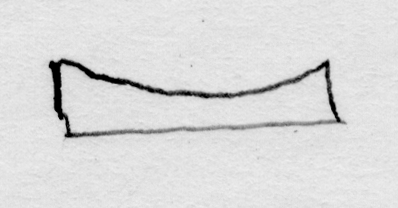
instead of 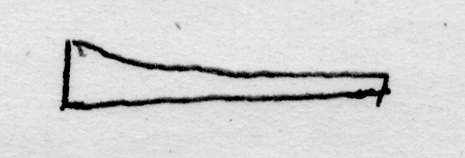 . Can there possibly be two mummies?
. Can there possibly be two mummies?
Dr. Scott came over for first time.
Carter removed the two swing doors from the
outer shrine.
Completed cleaning and sorting gold from
chariot decoration.
Carter removing objects from between outer and
second shrines. They include two alabaster jars, one in
"Union of the Two Lands" form, with side figures of the Nile,
the other in the shape of some feline animal. Also a number
of very fine ceremonial staves, maces, uas, fork bottom,
and two tied together, one headed by a gold statuette
of the King, and the other in silver.
Second shrine has upon it assembling directions with
the numeral 3. Therefore presumably four shrines in
all.
Newberry came over.
Third shrine apparent through door.
Noting chariot material.
Completed notes on chariot trappings. Body, pole
and axle of 122 also noted.
Market Day. To Luxor in afternoon for inoculation.
Carter at home ill.
Lacau visited No. 15.
Harknesses and Lythgoes arrived.
Interview with Lacau at Carter's house. Present Carter,
Harkness, Lythgoe & self. Subject recent demands of
Department for submission of names of staff for approval etc.
Carter flatly refused to make any more concessions, &
stated he stood by terms of his original concession.
Result absolute deadlock. Lacau returns to Cairo
tonight.
Harkness & Lythgoe visited tomb and 15.
15 native ladies to visit by request of government.
Finished noting the two decorated chariots.
Mrs Harkness, Mrs Lythgoe & Miss Stilman over
in Valley.
Waxed chariot 120.
Tele Several trays of new material brought up
to 15.
Telegram came summoning Carter to Cairo.
Left for Cairo.
To Alexandria to fetch Winifred and Margaret.
Back to Cairo in evening.
Went with Carter to see Tottenham, who
stated that the Minister of Public Works wanted to
see Carter in the afternoon, as he believed he could
talk him over.
Carter had a long consultation with Minister
in afternoon. Decisions held over till next day.
Carter saw Allenby in morning & then went on
to the Minister. Refused to comply with government
demands, informing him that he would write to
confirm. Afterwards he lunched with Allenby.
Left for Luxor in evening.
Spent the day unpacking and fixing the family.
Carter had a phone message from Tottenham asking
him to withdraw his letter, which he refused to
do.
To Valley in morning, where I spent the day on
chariots.
Carter returned.
Waxing parts of chariot.
Harknesses & Lythgoes in the Valley in morning.
Winifred & Margaret to see the tomb and No. 15.
Carter got first section of roof off outer shrine.
Still waxing chariots.
Morning only in Valley.
Holiday.
Started packing chariots. Carter found
that the lower steps of the staircase, and above the
door lintel above door were artificial, it having been
necessary to cut them away in order to get sections
of the big shrine into the tomb. ?
Second section of roof removed from the shrine.
This proved to have been put on wrong way round.
Presumably there was not enough room to turn it
round to correct the mistake.
Sir Herbert Samuel & party to visit the tomb.
Still finishing and packing chariots.
Third roofing block taken off shrine. This
section like the second was wrong way round. That it was
these two and not the first that was wrong proved
by the fact that the tongues did not fit holes and
had had to be removed or made smaller,
The first section & not the second and third was put
in wrong.
Packed body of chariot 122.
The Harknesses and Lythgoes over in the afternoon.
Becoming increasingly evident as shrine is
removed how carelessly the original work in the tomb
was done - not the original carpentry work, but
the fitting together. The Pall hung all askew.
The Shrine as already stated was orientated wrong.
The two upper boards were wrong way round. Considerable
force was used in putting together, and distinct
hammer marks were visible both on the gold and on
the wood below. This shows how strong the wood
gesso gold combination was originally. Now the wood
is almost as good as ever it was, but owing to
shrinkage the gesso has parted company, & has to stand
on its own for the most part without a firm backing.
Visitors trying all sorts of combinations schemes to
get into tomb. One party offered Bethell a bribe
of 25 piastres to let them in. A French journalist
tried to force his way into laboratory, and had
to be ejected almost by main force.
Helped Carter take off the pall. The sides
& top edges of the outer shrine had been strengthened to
carry the weight. Two strong planks were placed across
and on these we knelt, moving them forward alternately.
Starting at one end we first picked off the rosettes - of
bronze covered with gold foil - each of them had been sewn
to the pall with in four places. Some came off readily
enough, but with others the threads were still so strong
that they had to be cut with scissors. This was
necessary, both to reduce the weight, and to avoid
tearing the fabric when it was rolled.
A long roller has been prepared, to rest on the edges
of the shrine. and The end of the pall was placed
carefully over this, and then rolled gradually up over
the roller, the rosettes being taken off from one section
over another.
The pall was supported on uprights at the
four corners, with additional ones in the centre of
the two sides. At the top there was a rail into
which the supports 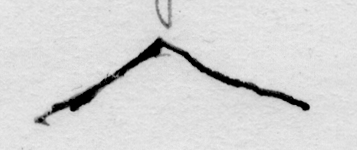 fitted into staples. In
fitted into staples. In
front of the door there were two additional bars, running
two thirds of the way down, joined to the side supports
by nails. These bars were bolted like doors, but in
their present position they could not have been used
as doors, the bolts being merely a former survival of an
earlier use.
Press day.
Packed away last of the chariot material, and
unwrapped and cleaned one of the two black statues.
Market Day.
Stayed in bed. Carter came round in the
evening, and after talking it over we decided to
open up the doors tomorrow.
At 2.45 the ceremony of opening the doors
began. There were present Engelbach (by invitation),
Harkness, Lythgoe, Winlock and the ordinary members
of the staff, including Newberry.
The doors of the outermost shrine had been
removed to facilitate work of recording. The seals
from the second had been photographed and removed
some days previously, and the doors were wide open.
The third door stood clear. At top and bottom
there large ebony bolts run into staples. In the
centre there were two smaller bronze staples,
and wound round these to form three strands, the final end
looping round all three strands to hold them together there
was a cord. This was sealed with a variant on the
ordinary Royal Necropolis seal, there being a cartouche
over the back of the jackal, and it is a further illustration
of the carelessness with which all the work in the tomb
was done that the sealing was partly on the cord, partly
on the right staple, and nowhere near the knot at all.
This seal, which had previously been photographed,
was carefully detached, and then the upper and lower
bolts were drawn and an attempt was made to open
the doors. For the moment this proved impossible, the
threshold of the second shrine being too high to allow
them to swing, but the difficulty was overcome by slightly
levering up the front and raising the cornice to allow the
doors to clear at the top.
The door of the fourth shrine now became visible, and that
it was the final one was rendered almost certain by the fact
that upon it were represented the figures of Isis and Nephthys
with outstretched protective wings. It had the same
ebony bolts above and below, and in the centre the same
staples for the sealing cord, but in this case there was no
cord and no seal.
Unlike the last these doors opened without any difficulty,
and within there came to view an enormous sarcophagus
of crystalline sandstone, filling apparently the entire space
within the fourth shrine. At the corners of this sarcophagus
carved in high relief upon the stone of the sarcop itself there
were the four protective goddesses of the dead, Isis, Nephthys,
Neith and Selket, the two latter being those at the end
nearest the door. Their faces were turned away from the
door and could not be seen; their arms and wings were
outstretched along the sides and ends of the sarcophagus. The
entablature comprised a frieze of inscription, a torus
moulding and a feathered cavetto cornice. The hieroglyphs
of the inscription were filled in with paint, as also
were details of the goddesses. The whole decoration was
incised and in heavy relief. At the bottom there was
a ring of dark colour imitating the bronze rim to
the bottom of the shrines.
Details of decoration of the doors
1. Outside Panels in centre with deities, & ornamentation as
on sides?
Inside Inscription only?
Check
2. Outside R King before Harakhte, with Maat behind him.
L " " Osiris, " Isis " "
Inside R 2 Deities of the Underworld, the inner one holding
a knife in either hand, the outer a knife in the
left hand, a palm leaf in the right.
L. Do. Do
3. Outside R. Similar deities.
L. " "
Inside R. Guardian Nephthys
L. Guardian Isis
4. Outside R Isis
L Nephthys
Inside R. Isis
L. Nephthys
Each of the three inner shrines (? Outer) has a winged disk
over the doors, with a feathered cornice above. Each door inside
and out has a conventional (dado) panelling below, continuing round
whole shrine.
All four shrines were marked at corners with the cardinal
points, and all were put in wrong. Therefore the
sarcophagus must either itself be wrongly oriented, or p
wrongly placed with regard to the shrines. These orientation
marks were scratched into the gold, as were also other
directions such as 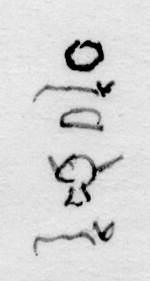 . There were other builder's or
. There were other builder's or
carpenter's marks, such as 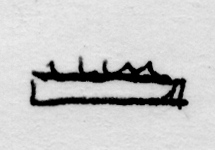 ,
, 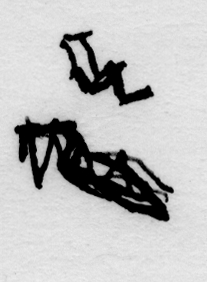 ,
, 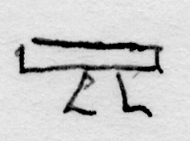 in black paint.
in black paint.
The representations upon the doors of inner shrines mark a regular
progress. First the King himself, making offerings to gods.
Then guardian deities of the underworld with knives
to protect him & palm leaves to ?, and
finally the protective goddesses.
Spent part of morning in tomb making notes.
Rest of day noting various objects in 15.
One of the Native Inspectors with family to visit 15.
Tottenham visited tomb & 15.
Carter stayed at home.
Worked on statue,  staves etc.
staves etc.
Waxing head of Statue 22 slowly with a pippette.
Care has to be taken to keep wax off the black
parts, as the resin would melt & run.
Market Day.
Packed one cow from couch, bases of couches,
& two or three smaller things. Rest of day on
statue.
Carter fixing tackle over shrines to enable him
to deal with the successive roofs.
Letter from Quibell to Lythgoe re Burton
& myself working in Museum in Spring.
Whole day on statue with Lucas.
Carter found roof of second shrine was put
on with large bronze tongues, which refused to
come out, and therefore, from additional height
they gave, making it much more difficult to
move in the confined space.
Visit from the Astor party.
Working on statue.
Statue again.
Carter has removed two pieces of cornice of
outer shrine. Difficulty of cleaning is that
the scaffolding necessary for one job makes it
impossible to do the next job.
S. side of cornice of outer shrine removed.
Finished waxing statue standing, and put it
on its back.
Press day.
Market Day. Went to Luxor for inoculations.
Finished statue, & started on sticks.
Carter got on section off roof of second shrine.
Carter took E section off roof of third
shrine. His idea was that then it would be
much easier to have the solid stone sarcophagus
to stand on in dealing with the remaining sections.
Instead he found that the innermost shrine had
a roof [in] one solid piece, not made like the
others which were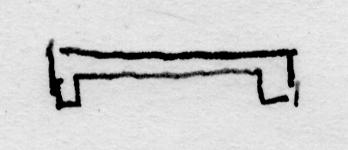 in section, but like
in section, but like
the top of a sarcophagus 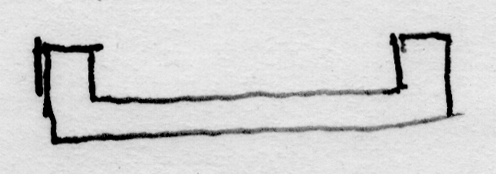 . This will
. This will
certainly be heavier than any of the other sections.
Plans had necessarily to be changed, and the
remaining sections of shrines 2 & 3 must be
removed before this innermost lid can be touched.
Plan of working is as follows. Two
wooden rollers are suspended on attached to
beams are suspended above the shrine roofs to serve
as raising tackle. These are so arranged that
they can be the frame in which they sit can be
pushed from one side of the room to the other.
The sections are raised by these rollers, and
brought opposite the door. There they are
bound on to ropes fastened to a beam in
the centre of the antechamber, down which they
slide. When clear of the door the section is
taken over by four workmen, and the ropes removed.
Stayed at Carter's house to have a conference
with Maxwell about the general situation, Did
not go up to Valley.
Spent most of morning photographing and
wrapping statue 22. In afternoon finished and got
it into its box.
Breasted came up in afternoon.
Prince Arthur of Connaught to see tomb in the
afternoon.
Working on sticks.
Finished packing first statue and got it out of the
way. Brought up second statue, & stood it up for
treatment.
Carter removed 2nd section of roof of third shrine.
Now only remains the roof of the fourth shrine, but this
being in one piece too heavy and large to move
without reconstructing scaffolding. Began removing
cornice sections from first shrine.
Market Day.
Fantasia for Mr Harkness's birthday.
Started work on second statue. Condition worse
than the first in that black resin had melted
and & run down all over gold.
Carter moved sides of outer shrine & leant them
against wall.
Continued work on statue, & started on second
tray of sticks.
Carter at work taking shrines apart.
Statue & sticks.
Breasted & Gardiner over.
All outermost shrine now taken apart. Doors
of second shrine removed & part of cornice.
Frame of third shrine door all in one piece.
Stayed at home discussing action to be
taken after receipt of Maxwell's letter.
Continued work on statue.
Press day.
Market day.
Mr and Mrs Newberry started working on pall.
In the afternoon, in presence of the archaeologists
of the Western Bank, Carter unwrapped the
five sticks - including the gold statuette
stick, the silver statuette stick, bows, bettl
beetle-wing sticks etc. The statuettes on the
gold and silver sticks were very definitely those
of a young boy.
All morning on statue.
Carter finished removal of second shrine. Between
this and third, on S & W sides there were
long ostrich feather fans, and on S & N sides
bows and arrows (Note exactly tomorrow).
In the afternoon with Harkness and Lythgoe
had a conference on the situation and decided
to wire Maxwell to come up again.
The fans referred to yesterday had elaborate
gilt handles, one shows a gazelle hunt. To
conform to position of fan-bearers on chariots both
fans should have been on W side. There were two
bows and arrows on S side, & one bow & arrows
on N side. The other N bow was resting on top of
shrine.
Carter cleared whole of 3rd shrine. Now only
fourth remains.
Turned second statue on back for treatment.
Bethel working on sticks.
Carter stayed at home this morning to consult
with Maxwell, Lythgoe & Harkness re letter
to Government.
In afternoon he raised the lid of 4th shrine
so that lid of stone sarcophagus became visible.
Shape W  set in. Lid was of
set in. Lid was of
granite painted red to imitate the sandstone
of the body of the coffin - another instance this
of the carelessness & hurry of the work in the tomb.
Re orientation. On stone coffin Isis and
Nephthys are at head end, & Neith & Selk
at foot. On fourth shrine these are reversed.
All shrines right through have their orientation
marks wrong way round, including marks on the
tongues. i.e. stone sarcophagus is correctly
placed, & shrines are deliberately set up wrong.
The doors of shrines should be at the head end
of sarcophagus. The original mistake was in
the construction of the tomb chambers. If the
shrines had been put in as intended, ingress
to inner storechamber would have been impossible,
and access to shrine doors extremely difficult.
The scenes on the fourth shrine are in relief, &
not incised like those of the others.
This morning Carter removed sides from the
fourth shrine & left disclosed the stone sarcophagus.
R Lid was naos shape inset. Sarcophagus
proper consisted of -
(a) Cavetto cornice
(b) Torus moulding
(c) Frieze band of incised inscription
(d) Panel of the goddesses
(e) Dado of 'dads' & 'thets'.
(f) Painted band to imitate the bronze bottoms
of the shrines.
At the four corners there were the figures of the
four protection goddesses, carved in high relief, with
details - eyes, jewellery etc. - picked out in colour:
Isis & Nephthys at head (west) and, Neith & Selk
at foot. The figures supported the coffin, reaching
with their arms as far as they could stretch,
& with wings outspread, crossing at ends, meeting
on sides. Shorter inscriptions (invocations of deities)
on ends and sides. On each sides, at south west end, a
single uzat eye incised.
The four corners rested on thin blocks of alabaster.
On S. side, in middle, there was a large painted
wooden `dad', its base projecting under the sarcophagus.
Sarcophagus painted with a wash of red (?)
Lid not of sandstone, but of granite. This had
been broken in two, the crack being filled up with
plaster. At west end a winged disk, part
relief, part incised. Also three vertical lines
of incised inscription, down centre and at sides.
The hieroglyphs in the inscriptions, or body at any
rate were filled in with colour.
The lid yet another instance of the haste and
carelessness with which the work in the tomb was
carried out. Probably the original lid was
broken in the manufacture, or in transit, and
there was no time to procure another suitable
block of stone.
The goddess figures are striking enough, but of
course are not to be compared with the free-
standing wooden figures in the inner store-chamber.
They follow a curious convention. Lower part of
bodies turned so that back and front of body is
represented, one on one side of corner, the other on the
other, whereas the upper part of the figure is square
to the corner, and holds it in a close embrace.
The heads of Neith & Selk face westwards, those
of Isis & Nephthys north and south respectively,
i.e. all four are directing their gaze towards the
head of the king.
Size of coffin sarcophagus proper
Lid rises.
Certainly the finest sarcophagus of its kind known.
In morning arranged programme with Carter, & wired
to Minister of Public Works, Tottenham and Lacau.
Official opening of sarcophagus provisionally fixed
for Feb. 12, and a Press view of sarcophagus on
Feb. 7. Carter to go to Cairo to see Minister on
night of Feb. 6.
Spent whole day on statue, and at last managed
to flatten down collar. One more day's work should
see it finished.
Bethell working on sticks.
Market Day. We all went for a trip
on the Khonsu to Gebelên.
Harknesses & Lythgoes went off to Dendera.
Carter left for Cairo to see Minister.
Finished waxing of statue 29, & waxed several
sticks.
American Minister and party.
Statue finished. Noting sticks.
Working all day on sticks.
Lythgoes and Harknesses returned.
Carter returned from Cairo. Came down to
lunch with him to talk over programme of opening.
Fixed for Tuesday, Feb. 12. Press View Wednesday.
Working all day on sticks.
Carter cleared away roof of fourth shrine,
so sarcophagus now stands clear.
Final preparations made for the raising of the
sarcophagus lid tomorrow. In order to raise in one
piece Carter had placed angle irons down
the sides and attached fastened to the protruding ends
the ropes to which the pulleys were attach fas attached.
At either end there was a one ton differential.
A communication from the Under Secretary of
Public Works, enclosing an order of procedure of
the opening, couched in very rude terms, and stating
that Carter must not invite more than twelve
to be present, including his own staff.
On Carter's list there were sixteen seventeen - Harkness,
Lythgoe, Winlock, Davies, Breasted, Gardiner, Newberry, Mond,
Aston, Foucart, Bruyère, Mace, Burton, Lucas,
Callender, Bethell, Derry. In reply Carter
asked the Under Secretary, who had been sent up
to represent the Minister, to meet him in the
morning to discuss the matter.
Moh. Pasha Zaghlul arrived in the morning, and
while Carter was showing him the tomb Lacau came
posting up. We moved up to No 15 for quiet
and there discussed the matter. After some argument
Zaghlul & Lacau agreed to the list of visitors.
The question of a visit to the tomb on the following
day (Press Day) of the wives & families of the
scientists concerned was then brought up. Invitations
to these had already gone out for about 20 in all.
Lacau raised objections. Zaghlul stated he had no
objections himself, but must wire his chiefs for
instructions. So the matter was left for the moment.
At 3 the party assembled
During this interview both Zaghlul & Lacau made a
particular point of the fact that Lucas was a
government official, and insisted that he be placed
on the government side of the list of visitors and
not on Carter's.
At 3 the party assembled and filed into
the tomb for the ceremony. It was discovered
afterwards that two Egyptian officials, including
a junior officer of the Police were introduced into
the tomb, who had not been on the original list.
Planks had been placed for in the antechamber
for the visitors to look do stand on so that they
could look down into the Sepulchral Chamber,
and it is worthy of note that the Egyptian
officials appropriated the front plank, Breasted
being the only outside scientist who got a
place. Subsequently Lacau made one of them,
the Luxor native Inspector, make room for
Gardiner.
In the Sepulchral chamber forces directed disposed
as follows -
Three workmen to east differential, Callender
and a fourth workmen at west differential:
Burton with his movie camera on the steps
leading down, Mace on north side of sarcophagus to make
the official notes, Carter directing.
At a given signal the chains were stretched and
the lid slightly raised. Then a pause to adjust tackle
and secure an exact balance. This done the word
was given to raise, and the lid swung steadily upwards.
At first sight nothing could be seen within but a mass
of cloth. Then looking closer we saw that this was a
kind of shroud placed upon the top of a large anthropoid
coffin, covering it entirely except for a few inches at
the top the west end where the upper part of the head
was bare. The raised foot end of the coffin came within
about two inches of the top of the sarcophagus, the
head some few inches lower. The shroud, except for
the small space above mentioned at the head, completely
covered the coffin, and hung down at the sides right to
the bottom of the sarcophagus.
At this point we had to restrain our curiosity
while Burton made some photographs. Then Carter
and I set to work to roll back the shroud. We found
that it consisted of two sheets of very fine linen.
The first was uppermost was laid loosely over the coffin,
reaching from the ankles to about the eyes. Its
sides hung downwards over the sides of the coffin, and
reached down to the very bottom of the sarcophagus.
Up the centre of this sheet there was a sewn seam.
Resting on this sheet & fallen at the sides there
were a number of fragments of granite from the
crack in the coffin. We may also note here
that beneath the st on the under side of the lid
of the sarcophagus, to hold the two pieces together,
there was a large dowel hole. The actual dowel was not there but
had presumably fallen to the side of the coffin. The
hole was coated with red cem plaster.
Starting from the head end the first shawl
was carefully rolled down & over the feet[.]
The second sheet had been laid over the body
with a slight excess at the foot and, this excess
being tucked down between coffin and sarcophagus.
It extended up to just beyond the forehead, at which
point it folded back and stretched as far as the
waist. Starting at this end it was rolled up
towards the head and then downwards.
In this last stage of the rolling it must have
been a thrilling sight to for the spectators, & we
heard them gasp as the head of the coffin was disclosed
to view. They had the best of it, for we who were
manipulating the cloth were unable to get a clear
view until we had completed our task.
The coffin when it had been laid bare was a
perfectly magnificent sight, covered with throughout
with gold & beautifully worked. From the forehead
projected the heads of the royal uraeus and vulture, the emblems
of the two kingdoms. Of them the vulture head in
particular was beautifully modelled. It had inlaid
eyes of crystal. A pathetic touch was added
by the fact that encircling & uniting the heads
of the uraeus and vulture there was a tiny
wreath of flowers. The face, beautifully modelled,
and evidently a real portrait, was covered with thick
sheet gold, in contradistinction to the rest of the coffin
which was gilding of the ordinary type. The hands
were crossed upon the chest. In the right was the flail:
in the left the crook sceptre, independent pieces these
of gold & blue faience. At the sides of the coffin,
engraved upon the gold, were the figures of two
protective goddesses, their arms and wings outstretched
above the to encircle the body of the King.
The coffin itself rested upon a low wooden bier,
with lions' heads at the head, very similar to those
on the throne.
It was decided to stop work for the year at
this point, as further cleaning could not be undertaken
without a long and uninterrupted period ahead.
We should note that immediately on coming out of
the tomb the police officer who was an unauthorised
spectator gave to Valentine Williams of Reuter's a full
account of the whole proceedings.
Early this morning Carter received a note from
Under Secretary, saying that he had received a wire
from the Secretary absolutely prohibiting the ladies
visit in the afternoon. He reported the matter to
us and we felt that we must refuse to carry
on any further work, as this was not only an insult
to us, but a clear sign that the government
were going to carry their policy of interference to
even further lengths. Under such conditions scientific
work became impossible.
Carter, Lythgoe and I went over to Luxor to
consult Breasted, Gardiner & Newberry. On the
river bank we met the Marmur and an officer
of the police, the latter of whom handed Carter the
following Order -
Ordre de Service
His Excellency the Minister of Public Works, having
replied by telegram that he regretted that he was unable
to authorize the visit of the wives of Mr Carter's
collaborators for Wednesday 13th February. His
Excellency the Under Secretary of State has just passed
to me the order to forbid until further notice, entry
to the tomb to all ladies who have not received
ministerial authorization as journalists.
In consequence, Mohammed Eff. Shaaban, Antoun
Effendi Youssef and Ibrahim Eff. Habib, must forbid
entry to the tomb to all ladies who have not a written
authorization.
It goes without saying that they should carry out
this order with all desirable courtesy. Mr Carter
has been advised of this measure.
Directeur Général
Service des Antiquités
(Signed) P. Lacau
Luxor, 13 February, 1924
The Marmur asked if Carter would lend him his
car to take him to Mr. Mond's work. Knowing where he was really going Carter replied that he
would let him have it as a friend, but that if he were
taking anyone with him he could not lend it. The
Marmur hesitated & finally Carter told his driver to
go home.
We then went over to Luxor and had a conference
with Breasted, Gardiner and Newberry. It was agreed
that in view of the Government's repeated interferences of
which this was the culminating example, the staff should
refuse to carry on work until things were put on a more
satisfactory footing. A statement to this effect was
drawn up and typed, to be put on the notice board
in the hotel.
Carter and I then went to call on the Under
Secretary on his boat but found he was not there.
The statement was put up on the Notice Board
of the hotel at 12.30 P.M.
Lunched with James who had come up to see
Carter & who professed utmost sympathy. He
advised sending a telegram to Premier which
Carter did. In the afternoon we called on the
Under Secretary at about 2.30, and Carter announced
that he had closed the tomb & was going
to take steps. The Under Secretary seemed to think
the whole thing was a joke.
We then returned to the hotel, and set Merton
going on statements to be telegraphed to the Times.
On our way across we called in at the Chonsu
to see Harkness and Lythgoe.
At some time 5.45 p.m. in the course of the day an
order was issued, signed by Lacau, to the Antiquities
Inspector, to refuse permission to anyone to enter
either the tomb or No. 15. ? At what time of day
was this issued. In any case the Marmur & a
police officer had go been ordered to the Valley to
enforce the law about ladies' visit before Carter had
done anything to show whether he intended to
In this connection an account of the Marmur's
movements will be of interest.
He was ordered to the Valley some time in the
morning. Meeting Carter on river bank he tried
to obtain loan of car, camouflaging his movements by
saying he only wanted it to take him to Mond's
excavations. Failing in this he arbitrarily
commandeered a cab which had been ordered by a
party of tourists, and drove off in it, leaving the
tourists stranded. At Mond's he left the
carriage & borrowed M's car to drive him &
his party to the Valley. There he told the
chauffeur to come back for him at about 3 o'clock.
Meanwhile Mond had found out what was up
and refused to let his car go back. After
waiting an hour or so he telephoned the Omdeh
to go and ask Winlock to send our car for him.
We got the message on our return at about six
o'clock, and Winlock replied that as he was
in the Valley for the express purpose of keeping our
wives out of the tomb it was hardly up to us
to fetch him away from it. Eventually he left the
Valley by donkey at about 6.15 P.M.
Went round to Carter's in the morning.
Answer came from Premier saying that he
approved of action of the Minister, and stating that
the Government were entirely within their rights.
Carter's reis reports that the police force in the
Valley have been increased to ten, and that he
was interfered with when he tried to sweep the
steps leading down to the tomb.
In the afternoon Carter went over to call on
Harkness & Lythgoe, who were delaying departure
another day to watch events.
In the morning Carter, with Winlock as
witness, went up to Valley to get definite proof
that he was refused access to the tomb. The
Marmur was there, but he stated that he was
only over there with friends. Ibrahim Eff.
showed him an order signed by Lacau stating
that no-one was to enter either the tomb or No. 15, neither
Carter, nor anyone else. Spent the afternoon writing
up diary.
Wire from Maxwell saying that he was arriving
tomorrow morning.
French papers in Cairo virulent in their abuse
of Carter. Also quote letters from Lacau to
the Minister written in January, in which
he urged the latter to stand firm. One of
them also contained the statement that Carter
took fees from the Cairo and Luxor hotels.
Went over to lunch with Carter, and saw
Breasted and Newberry.
Maxwell arrived. He and Carter went up to Valley
to see if order excluding Carter was still in force.
On return dispatched a telegram to Minister P. W.
demanding right to enter tomb & 15 to carry out
certain necessary work to safeguard objects during
the interval that must elapse before any work
could be resumed. If Government refuse this his
idea was to immediately issue a writ. In any
case he stated that Carter should refuse under
any circumstances to deliver up keys.
Interview with Maxwell in the morning. Rest
time writing up White Book.
Telegram arrived from Minister in answer to Carter's
stating that he could enter tomb if he would
prepare for visits. Carter replied refusing to
do this unless an apology was forthcoming, and
assurance of no more interference.
Working at Carters all day. After tea went
over to Luxor.
Heard that Engelbach had been informed that
all visits to tomb were indefinitely postponed.
Stayed at home writing, as Carter was in
Luxor to meet Allenby.
Eclipse of the moon.
Working all day on statement of case.
Telegram from Minister that Council of Ministers
had passed an arrete confiscating the tomb,
and stating that it would shortly be reopened by
Government.
Letter from Maxwell stating that he had had
an interview with the Minister, and that, finding
that they would not recede from their position, had
set the writs in motion.
Telegram from Lacau saying he was to open the
tomb at 2 P.M., and asking Carter and his collaborators
to be present. Later in morning a letter in similar
terms sent by hand from steamer. Carter replied that
he failed to see why the tomb should be opened today,
and considering that the question of sequestrationship
was to come up in the Courts tomorrow, and the question
of safeguarding the objects was not urgent, but could
well be left until after the decision of the Court.
At about a quarter to two Lacau drove up the
road, and stopping at the turn to Carter's house
sent a policeman with a letter asking for the keys,
saying that if they were not forthcoming by 2.30
he would break open the gates. Carter replied in writing,
refusing to deliver up keys, and making a formal protest
against Government's action.
From reports received from Moyne, and from
Carter's reis, we learn that there went to the Valley
on this occasion Lacau, Engelbach, Baraize, Mudir,
Marmur, Commandant of Police for district, a member
of the Department of Justice, the a mechanic with
assistants, and 33 soldiers and police, camel corps,
cavalry and infantry. The locks on wooden door
had been sawn out, & those of steel gate filed off.
The tomb had then been entered and apparently various dispositions
made therein, as the party remained in it about an hour.
They had then emerged & put government locks on the
doors. After this they moved up to No. 15, but
apparently contented themselves there with filing off locks
and replacing with another or others.
Working all day on White Book.
Hear that the party were to return to the Valley
today, to make procis-verbale on No. 15.
Telegram from Maxwell to say Court had been
adjourned until 3.30.


